1lumen selects and reviews products personally. We may earn affiliate commissions through our links, which help support our testing.
Ripsshine HF1 review
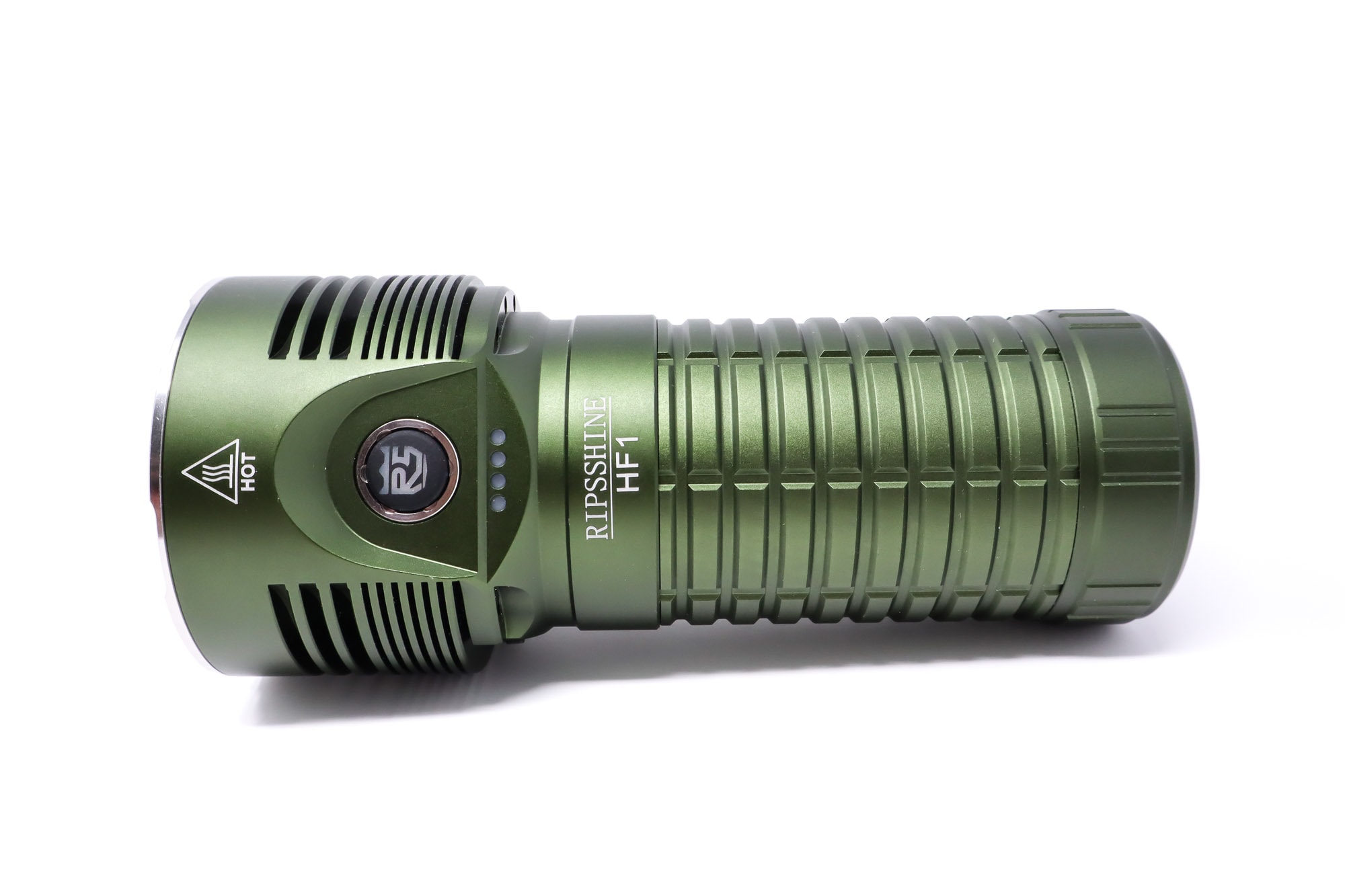
Ripsshine HF1 specifications
| Brand & Model | Ripsshine HF1 |
|---|---|
| Flashlight category | High Output General Purpose |
| LED | 6*Cree XHP50.2 HD |
| Max. output | 20,000 lumens |
| Max. beam distance | 580 meters |
| Max. beam intensity | 70,225 cd |
| Battery config. | 46950 battery |
| Onboard charging | USB-C |
| Main modes | 6 |
| Blinkies | Strobe, S.O.S., beacon |
| Waterproof | IPX8 |
| Review publication date | March 2024 |
Review intro:
It’s a good time to be a flashlight enthusiast. There’s no dearth of relatively inexpensive high performance lights. The small, indie start-ups in particular offer their own interpretations of consumer and enthusiast-grade flashlights. I’ve reviewed some lights from the oft known brands before, but the one up for review today is one that I hadn’t heard of outside of enthusiast circles. Unless you’re an occasional Chinese window shopper like I am, you probably haven’t heard of it either.
Enter the HF1 from Ripsshine.
By now, if you haven’t already Googled the name, Ripsshine is a small start-up company with a very slim portfolio of lights, 4 in total, with this HF1 as the flagship offering. They’re only for sale from China, so they’ve yet to garner any serious exposure. Naming convention aside, this one promises to be a hoot and thanks to the feature set, joins a pretty small populous of flashlights. It also takes some design cues from another light starting with M and ending with ‘ach.’
What’s in the package
The HF1 came in a pretty plain box for a high price light. I’m not complaining though because it;s utilitarian like Thrunite’s boxes. The bit carrying the light pulls out from the side. Inside it’s nestled in foam with the accessories
- Ripsshine HF1
- Ripsshine branded 32 Ah 46950 battery
- O-rings
- Instruction manual
- Lanyard
- USB type C cable
This is a ready-to-go kit. However for my sample it was DOA…well, the battery sure was! Even with the stick-on isolator, the battery had somehow discharged so low it tripped the protection board. The cell read 0.73 volts out of the box, and it required almost 13 hours of charging to get it back to 4.14 volts. The included lanyard is made from 3/16 paracord and has a quick release clamp on one end. Otherwise, pretty standard stuff.
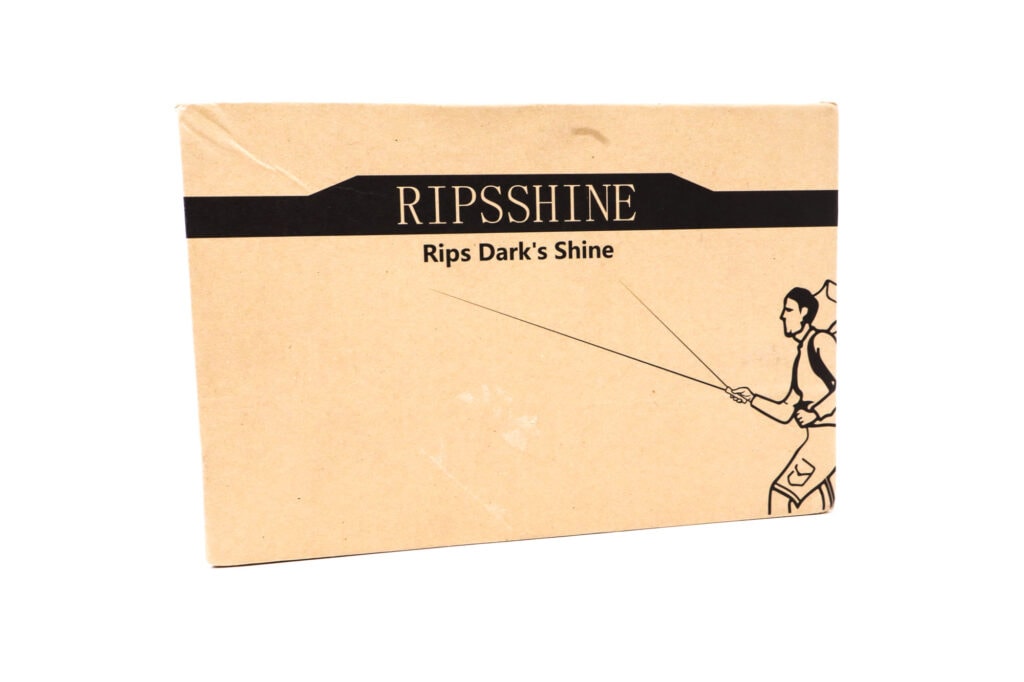
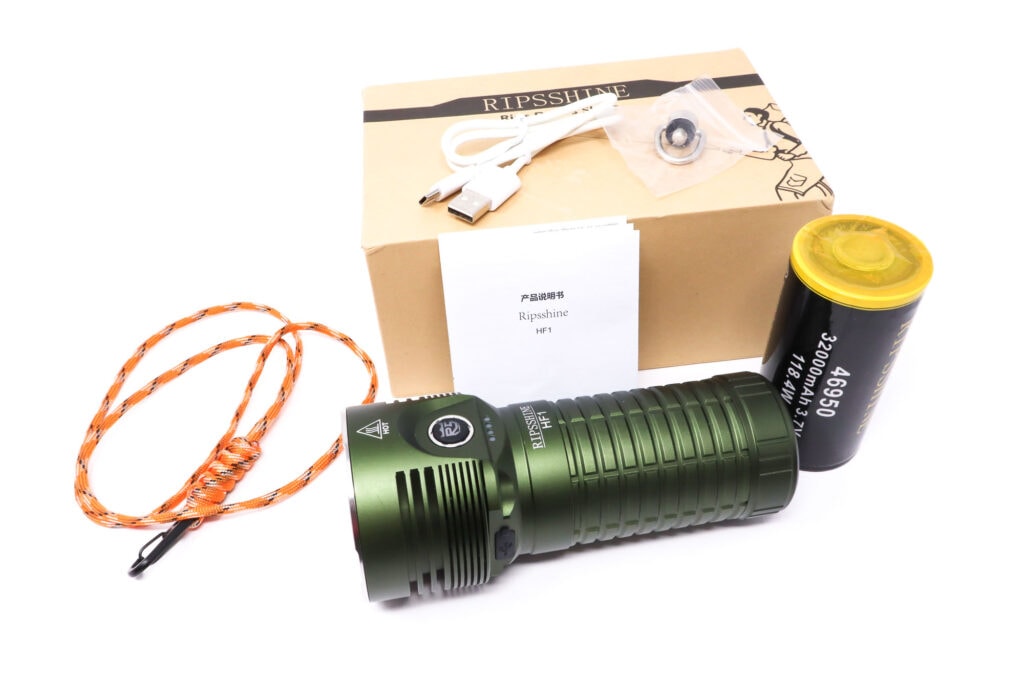
Flashlight in use, Build Quality, and Warranty
The HF1 follows the same vein of the newest crop of high output lights with the humongous 46950 li-ion cell. In fact, if you’re thinking, “Hey, that looks like the Lumintop Mach!” you’d be right because the HF1’s design was influenced by that light. This is a thick bodied, multi LED, fan-cooled flooder. Like the Mach, its handling is identical. It’s really heavy, the tube is girthy, and fills my big hands. While not a huge light, it’s still a handful. The body has some nobbles and grooves that are less aggressive than the Lumintop Mach’s, but were plenty grippy. For retention, you can holster it or sling it. There’s a ¼-20 UNC threaded mount on the backside of the head for a tripod shoe or mounting a swivel stud or bail. Ripsshine includes one in the box, a stainless steel threaded mount with a folding bail. The included lanyard can thread on it, or clip on.
The head flares out a bit from the tube, and has lots of thin, deep fins surrounding a hollow cavity under the LED shelf. Housed in the cavity is a central cooling fan. Air is drawn from the sides and exhausted upwards over the LED shelf and fins. There’s a single e-switch behind the bezel in the middle of the head in a flat cutout for resting your thumb. It’s easy to find by feel and works just fine.
The clicks are positive and feel about like any good e-switch. There’s a row of 4 LED indicators below the switch for on state, battery condition, and charging. The switch boot itself is pretty cool. It has a translucent Ripsshine logo that changes color (turns red) when set to fan-on, and turns off for fan-off mode.
Build quality for the Ripsshine HF1 is really good! I don’t know if these are made in-house or by an ODM, but they’ve done good with no major quality issues. Overall fit, finish, and feel is great! For sale direct from Ripsshine for around $200 US, you get an active-cooled flashlight with a big battery. Constructed from an undisclosed aluminum alloy (probably the standard 6061), the machining is nice and tidy with no anomalies to speak of. Zero tool marks, and everything lines up with no gaps. It’s not specifically mentioned, but the finish is probably some kind of hardcoat anodizing. It comes in two colors: Black or green. The sample came in green, and it’s a nice shade with more of a semi matte finish, which I like.
The body threads are fully anodized rectangular units and they’re very precisely cut and smooth with adequate amounts of lube. There’s o-rings sealing every joint as well: Both ends of the tube, bezel, and the lens, and the IP rating is IPX8. Even though not the proper IP68 I see on other higher-end lights, it’s still good for 1 meter of immersion for 30 minutes and a 1.5 meter drop rating. Ripsshine says the fan will even work when submerged (like the Mach). No, I didn’t test it. On the backside of the driver there’s a circular contact for the battery + and – separated by a plastic insulator (for reverse polarity protection). No springs here folks! The tailcap’s insides are fully anodized, and the battery is separated from the tailcap with a thick rubber gasket.
For the warranty, from the manual: 30 days replacement/DOA guarantee for free replacement or return. 5 year guarantee for functionality not resulting from abuse, normal wear, or intentional damage. Accessories are covered with a 1-year guarantee.
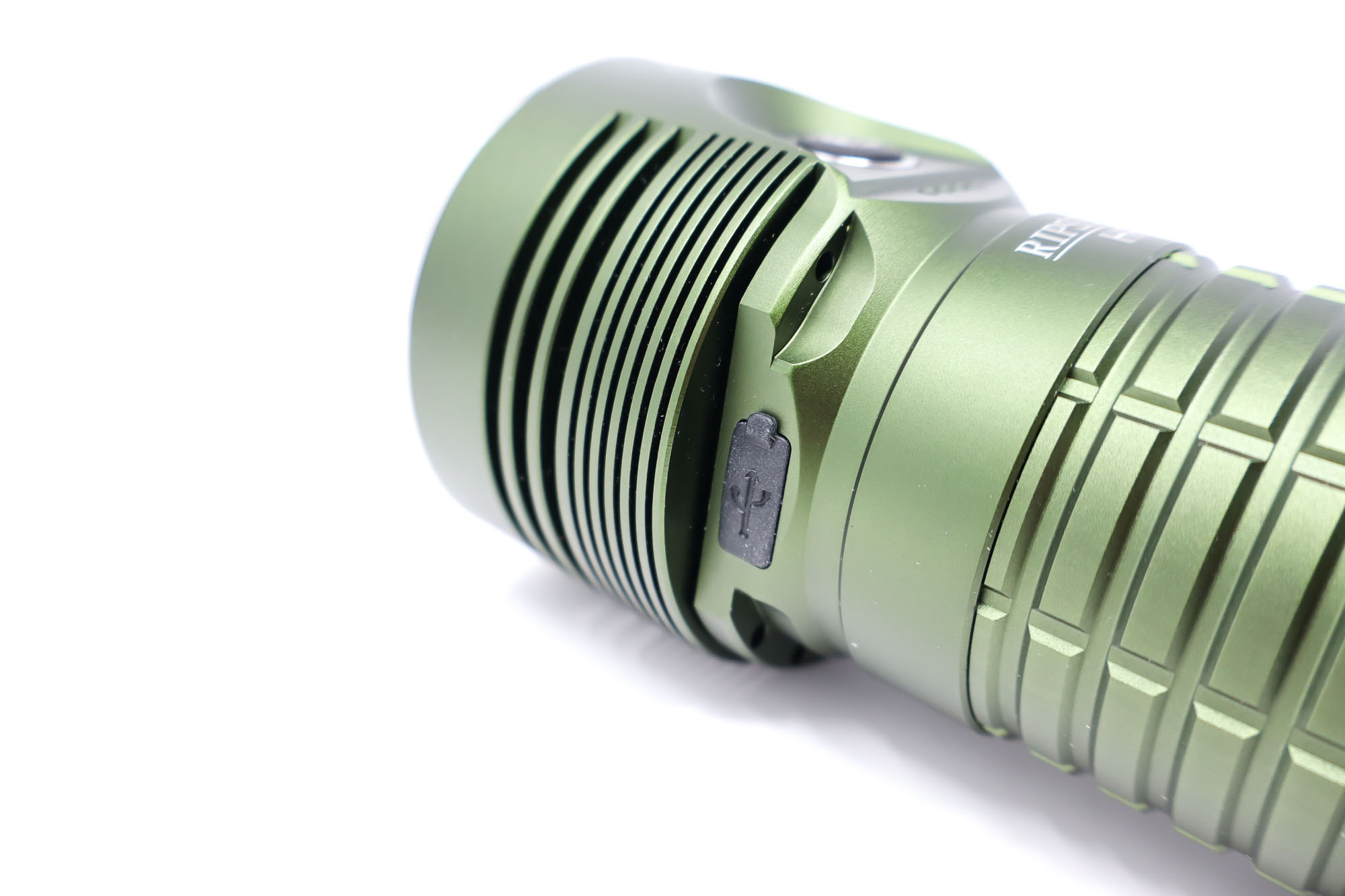
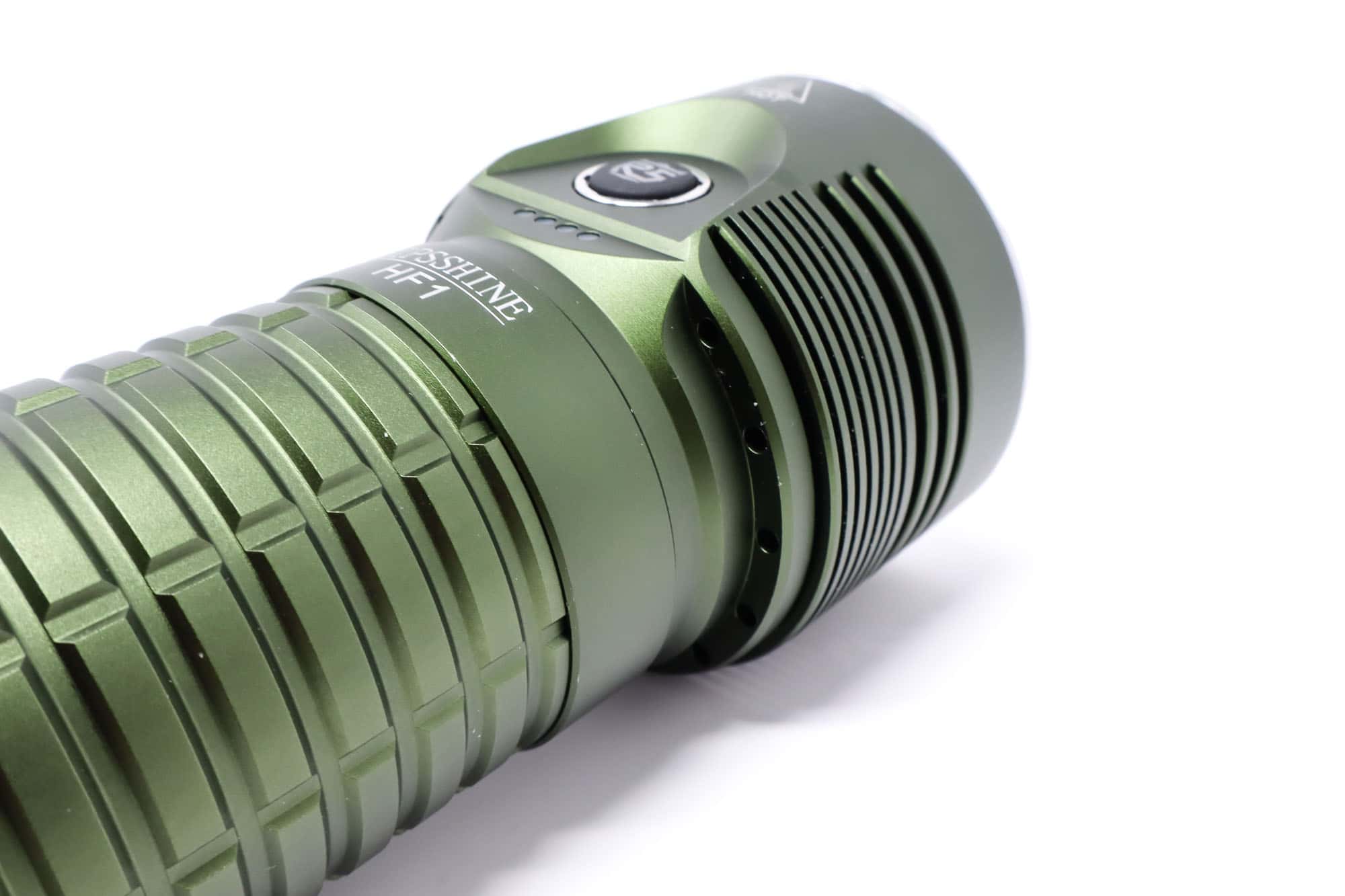
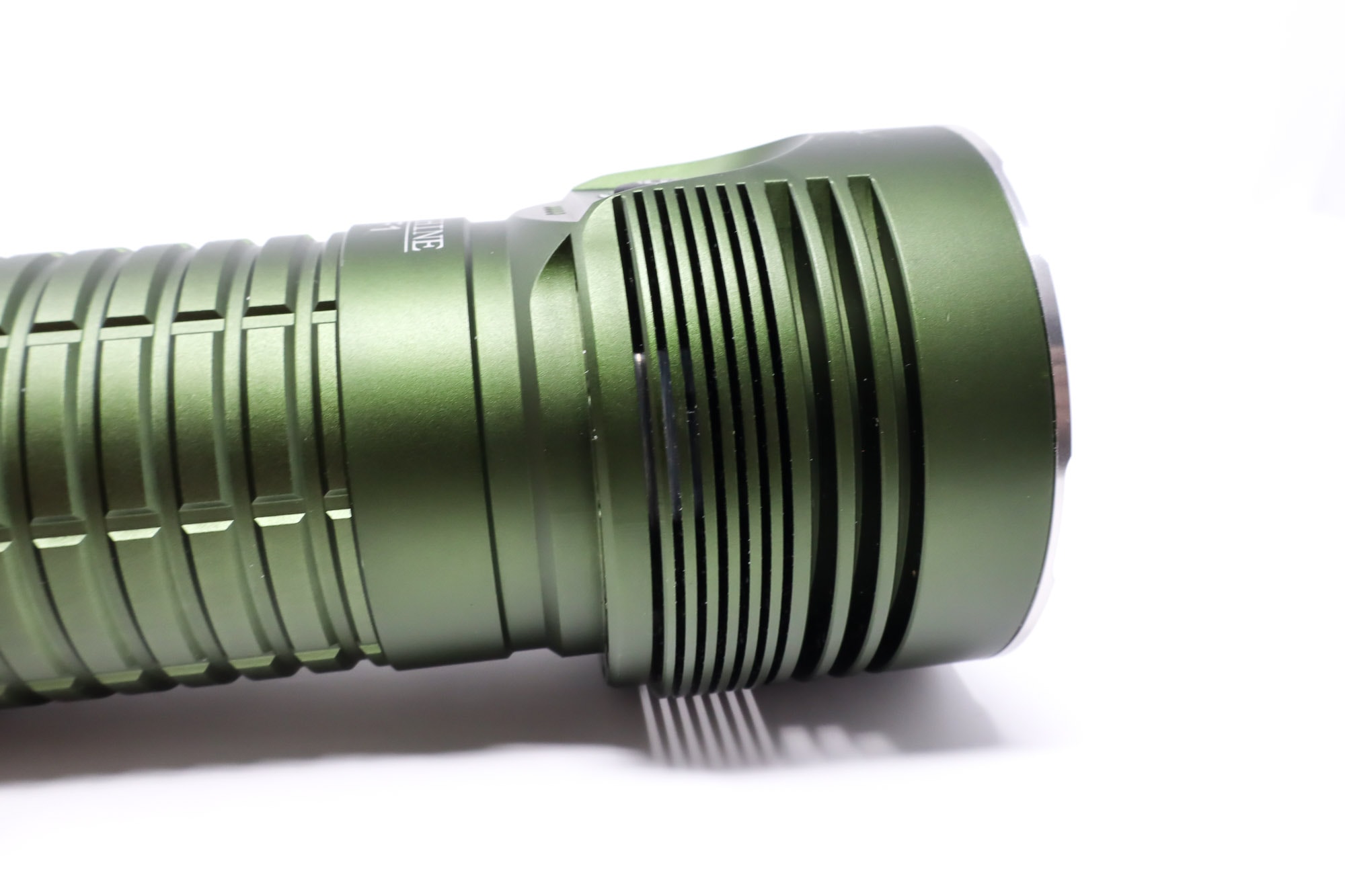
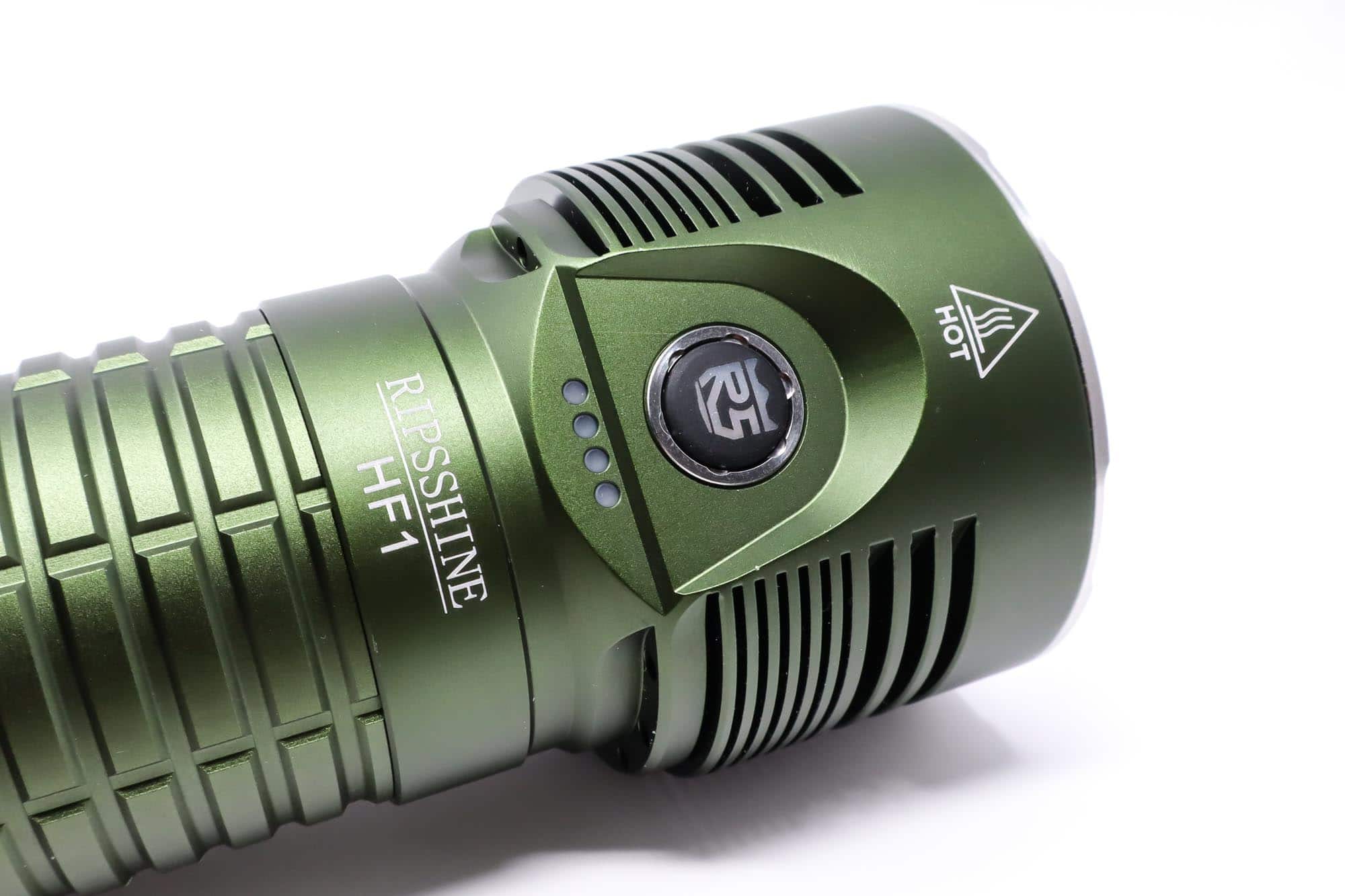
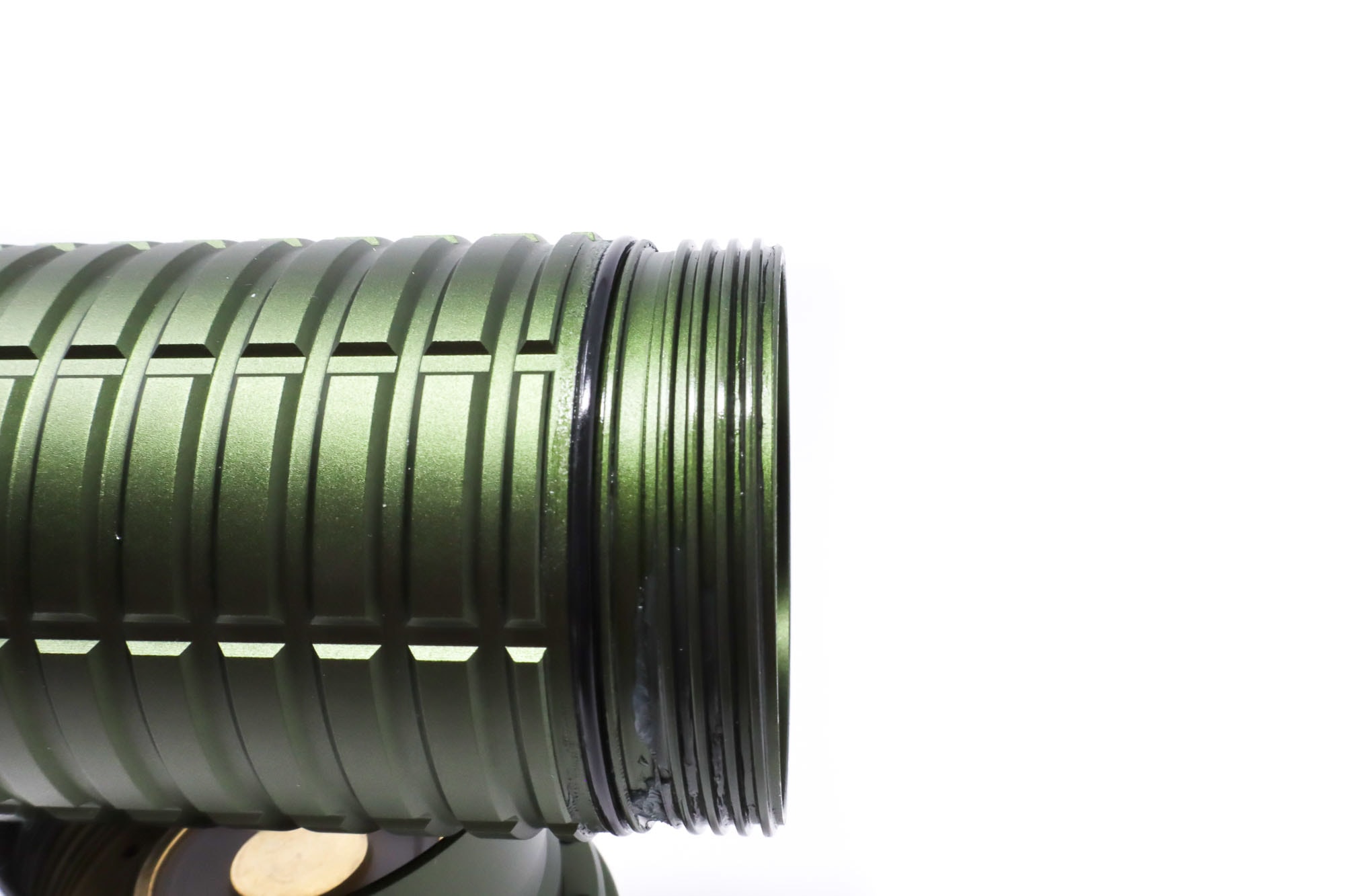
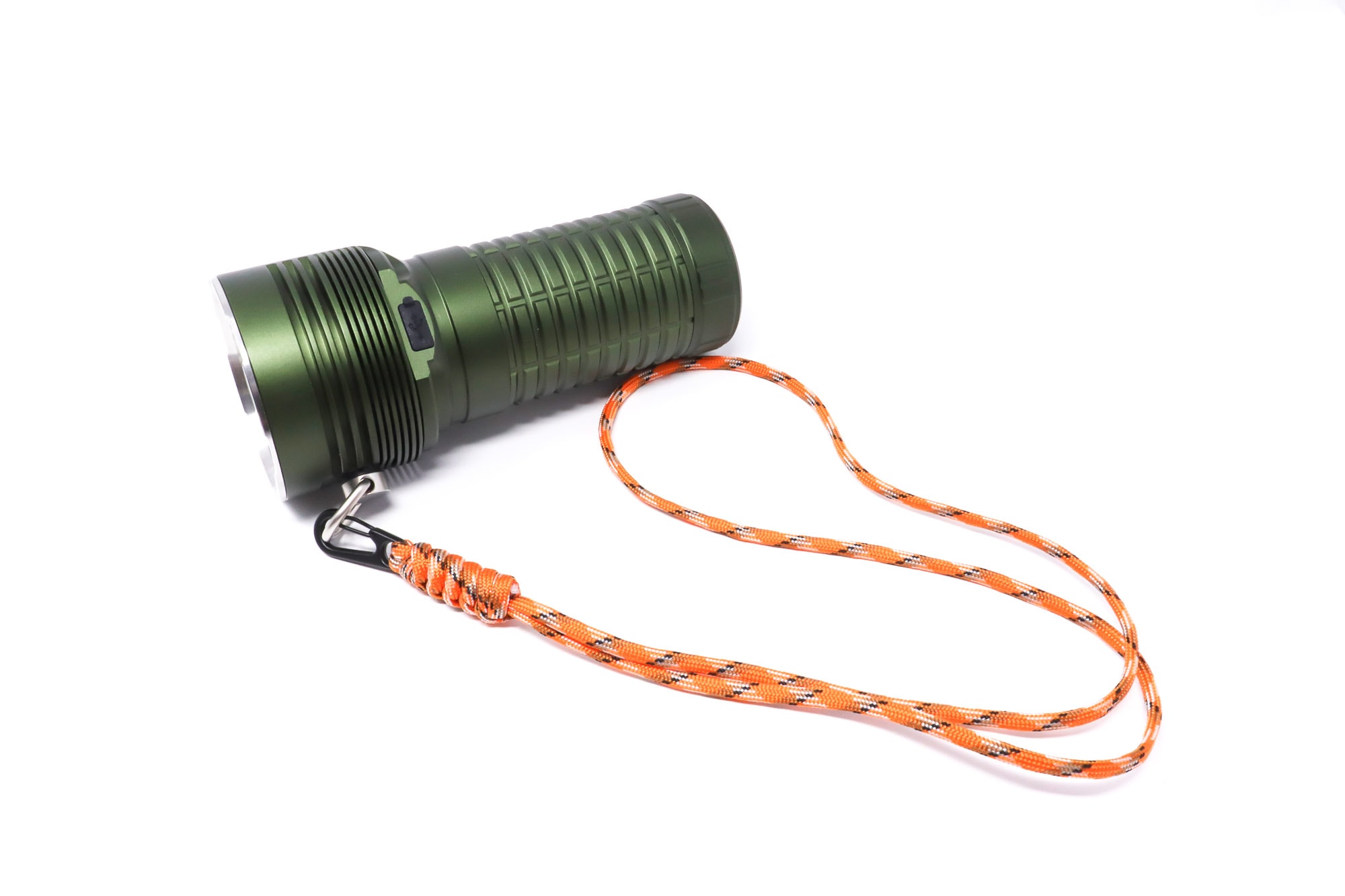
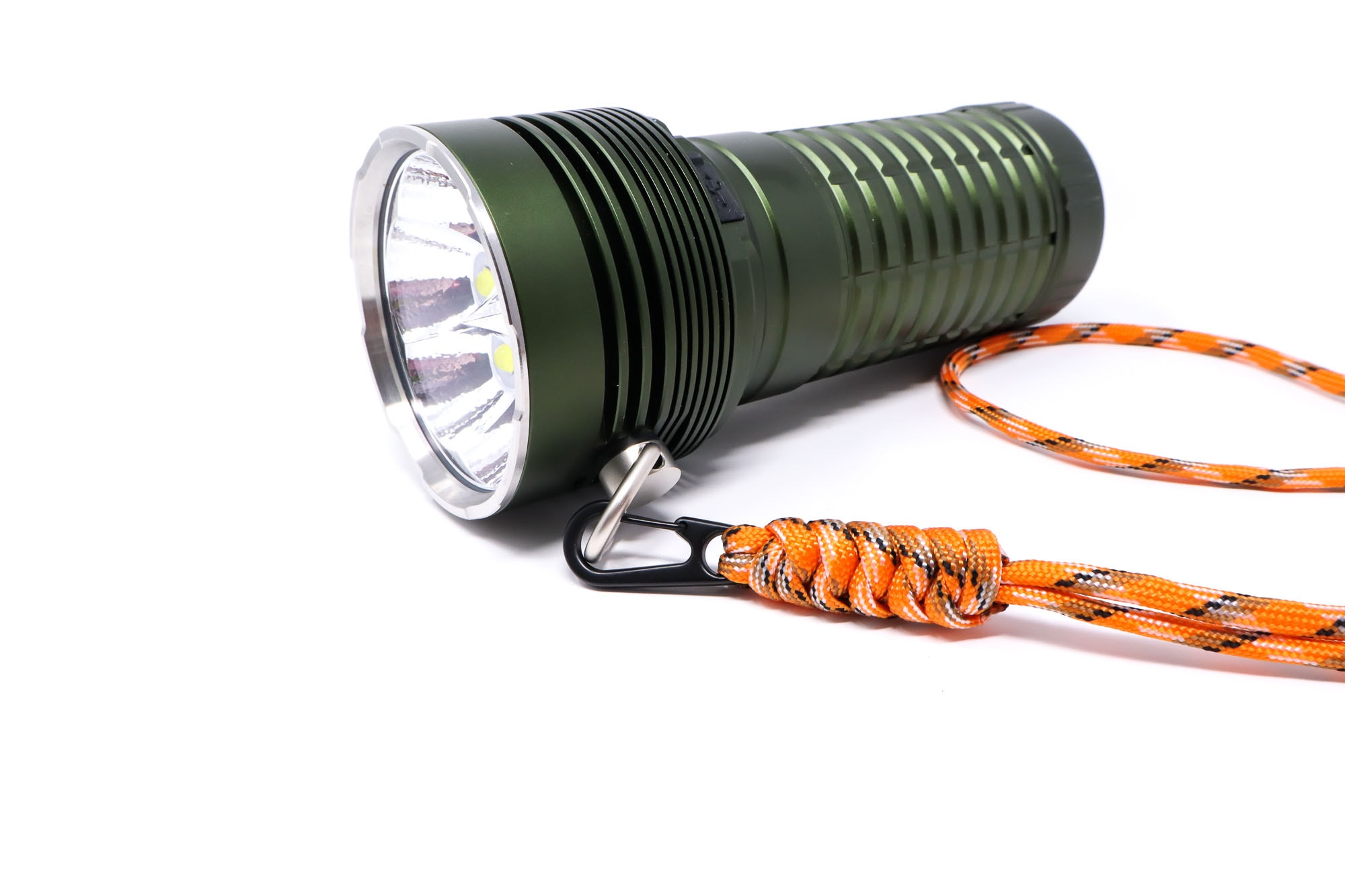
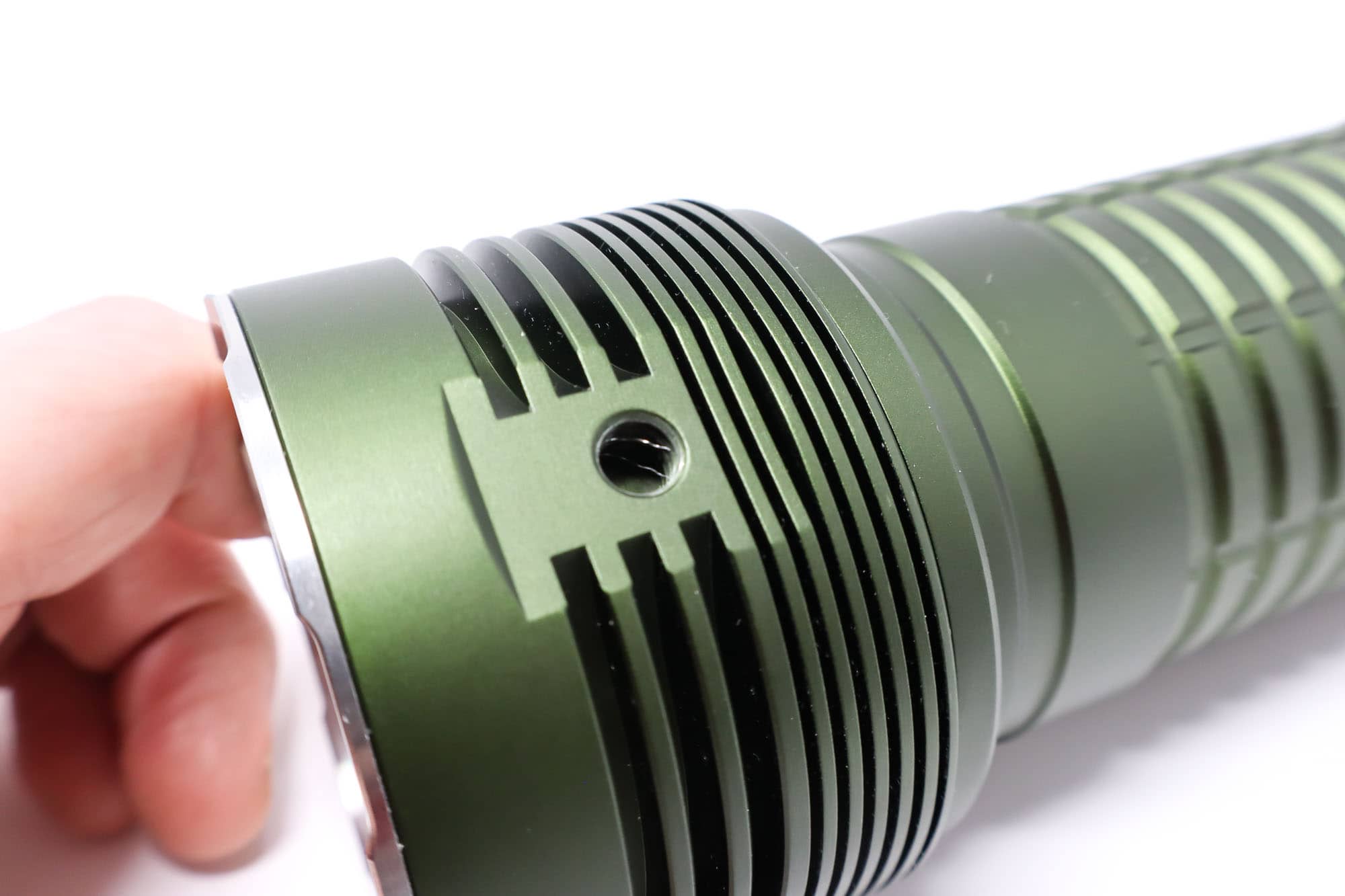
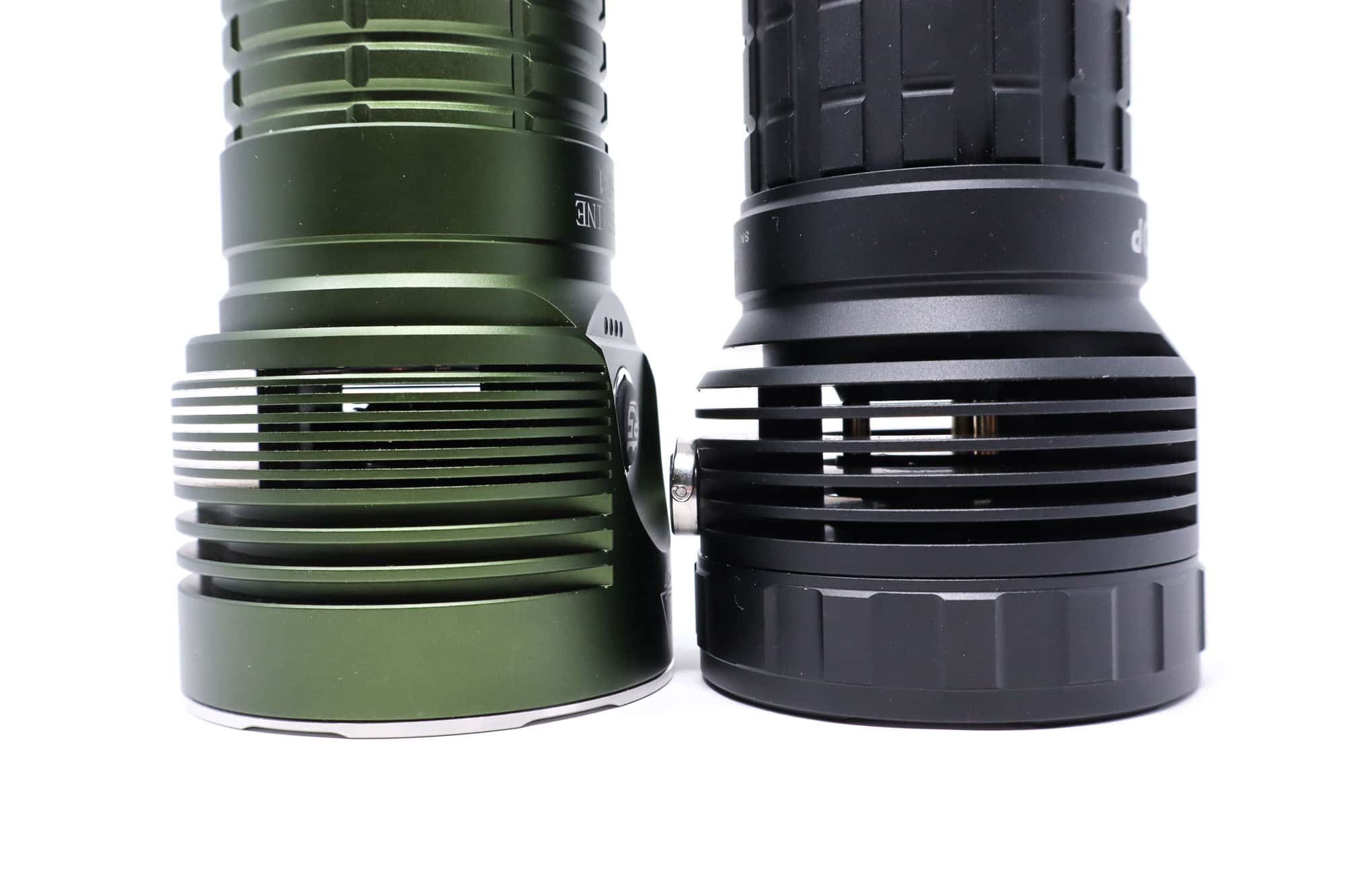
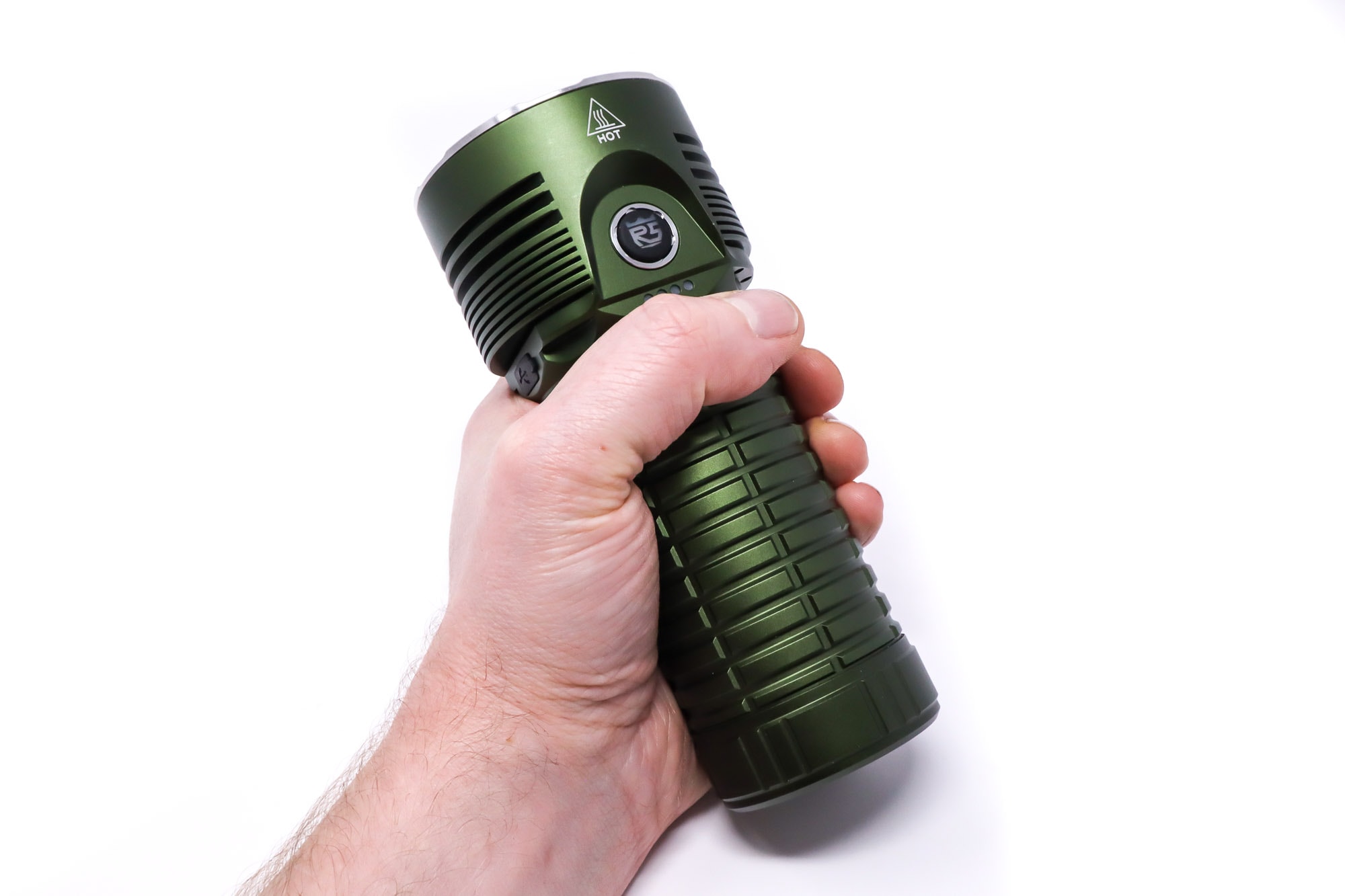
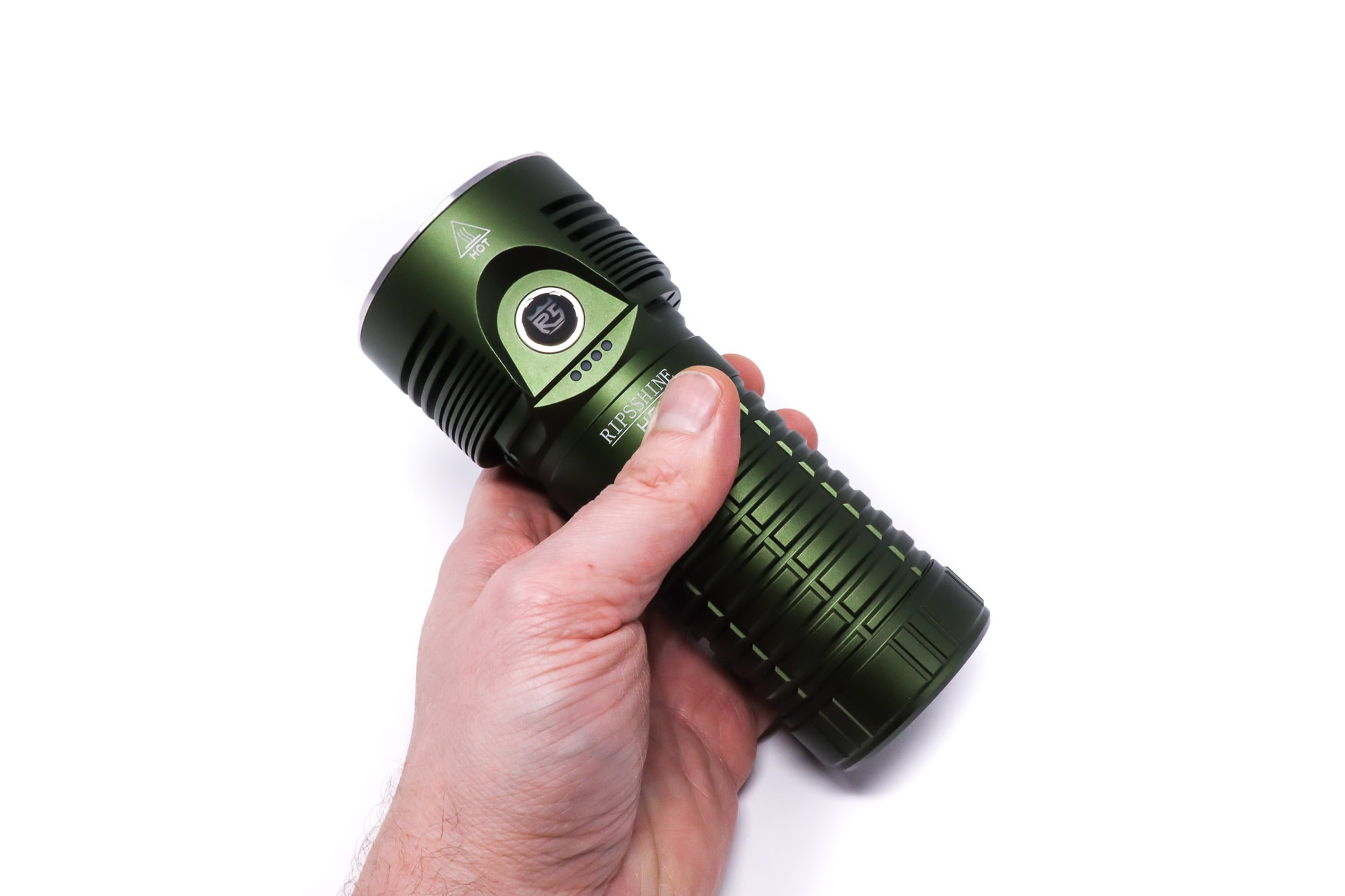
LED, Lens, Bezel, Beam, and Reflector
The HF1 uses Cree’s 2nd gen XHP50 LEDs and you get 6 of them. These are the domed version with 4 individual light-emitting dies on a single substrate. It’s a flip chip design, and is capable of very high output and can be had in 3, 6, or 12 volt variants. This LED is super common, and while recently overshadowed by the 3rd gen XHP50, this one’s still alive and kicking These LEDs are probably the 3 volt version, and come in the obligatory cool white tint (for maximum output of course).
The LEDs sit under a 6 cup OP reflector with each cup arranged radially. Unlike the Mach, there’s no air intake in the middle of this reflector. The reflector is topped with a hardened mineral glass lens with an AR coating (a light one), capped by an aluminum bezel. The beam is typical of multi LED lights with some nice distance behind it. There’s a somewhat visible bright spot, more noticeable than the Mach, but it’s mostly all flood. The beam is pretty clean, but the tint shift is present, with a pee yellow corona and a bright blue/white inner area.
Spectral measurements:
I used an Opple Lightmaster Pro to measure the flashlight at 1 meters from the sensor
| Mode: | CCT: | CRI Ra: | duv |
|---|---|---|---|
| Turbo | 5695K | 65.6 | 0.0087 |
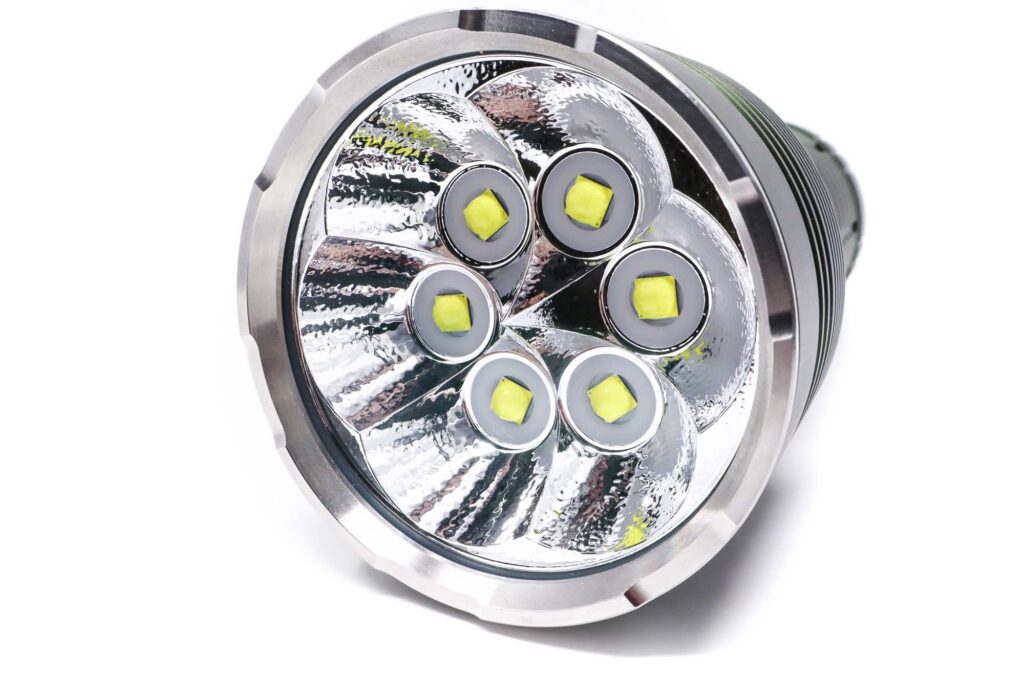
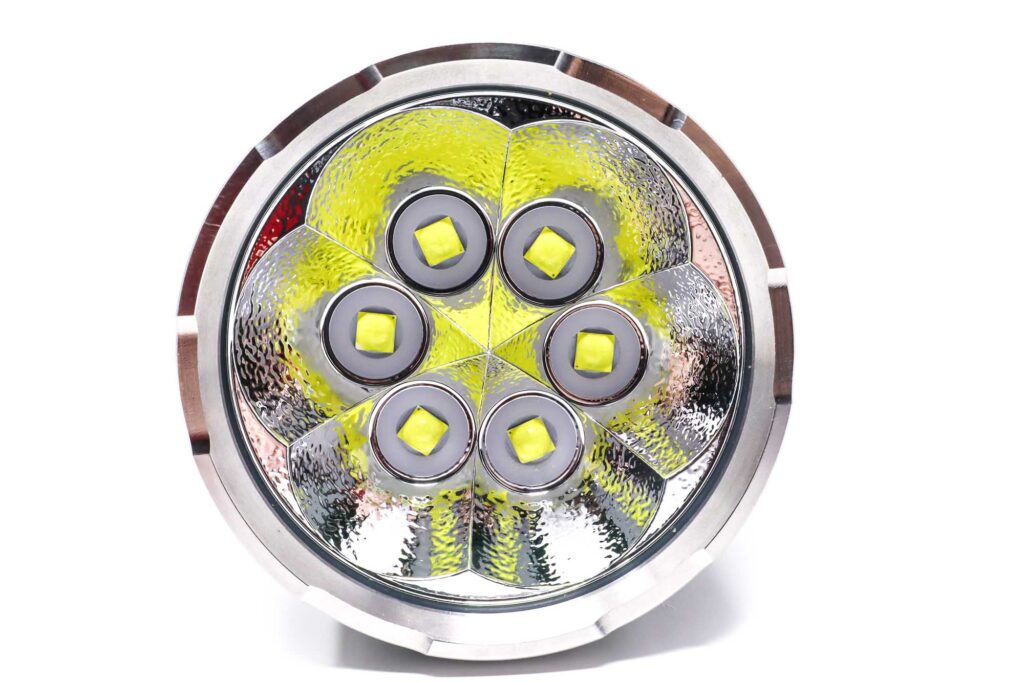
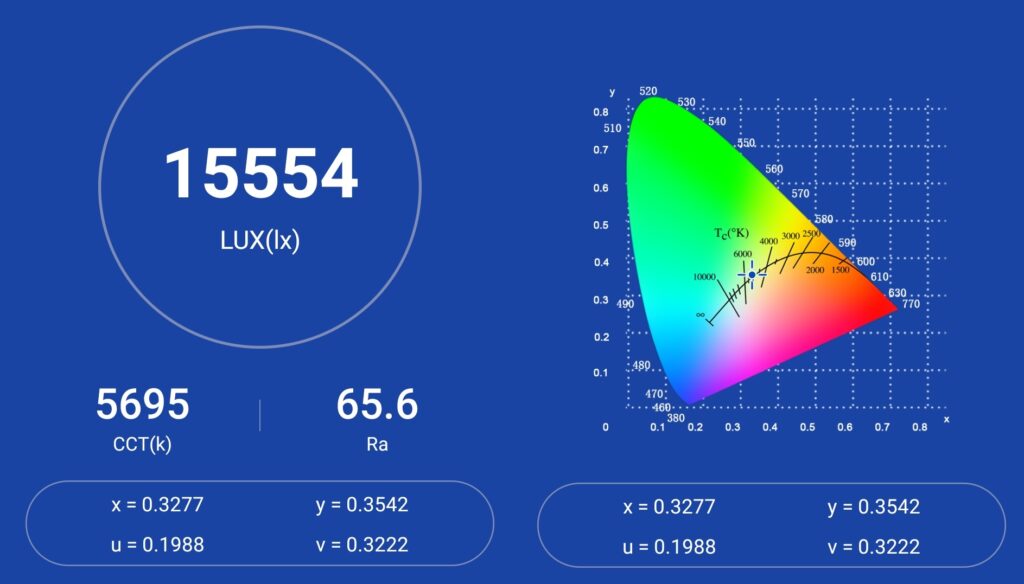
Dimensions and its competition
Dimensions:
| Ripsshine HF1 | Millimeters | Inches |
|---|---|---|
| Length | 155 mm | 6.1 in |
| Head diameter | 60 mm | 2.4 in |
| Body diameter | 52.5 mm | 2in |
Dimensions are rounded to the nearest millimeter and the nearest tenth of an Inch.
Weight:
| Ripsshine HF1 | Weight in grams | Weight in oz |
|---|---|---|
| Without battery | 416 g | 15 oz |
| With battery | 836 g | 29 oz |
Weight is rounded to the nearest gram and tenth of an Oz.
Flashlight size comparison with its competition:
Group 1 left to right: Lumintiop Mach, Ripsshine HF1, Lumintop Thanos 23
Group 2 left to right: Sofirn SP36 Pro, Wurkkos TS32, Ripsshine HF1, Thrunite TN50, Amutorch DM80
Group 3 reflectors left to right: Ripsshine HF1, Thrunite TN50, Amutorch DM80
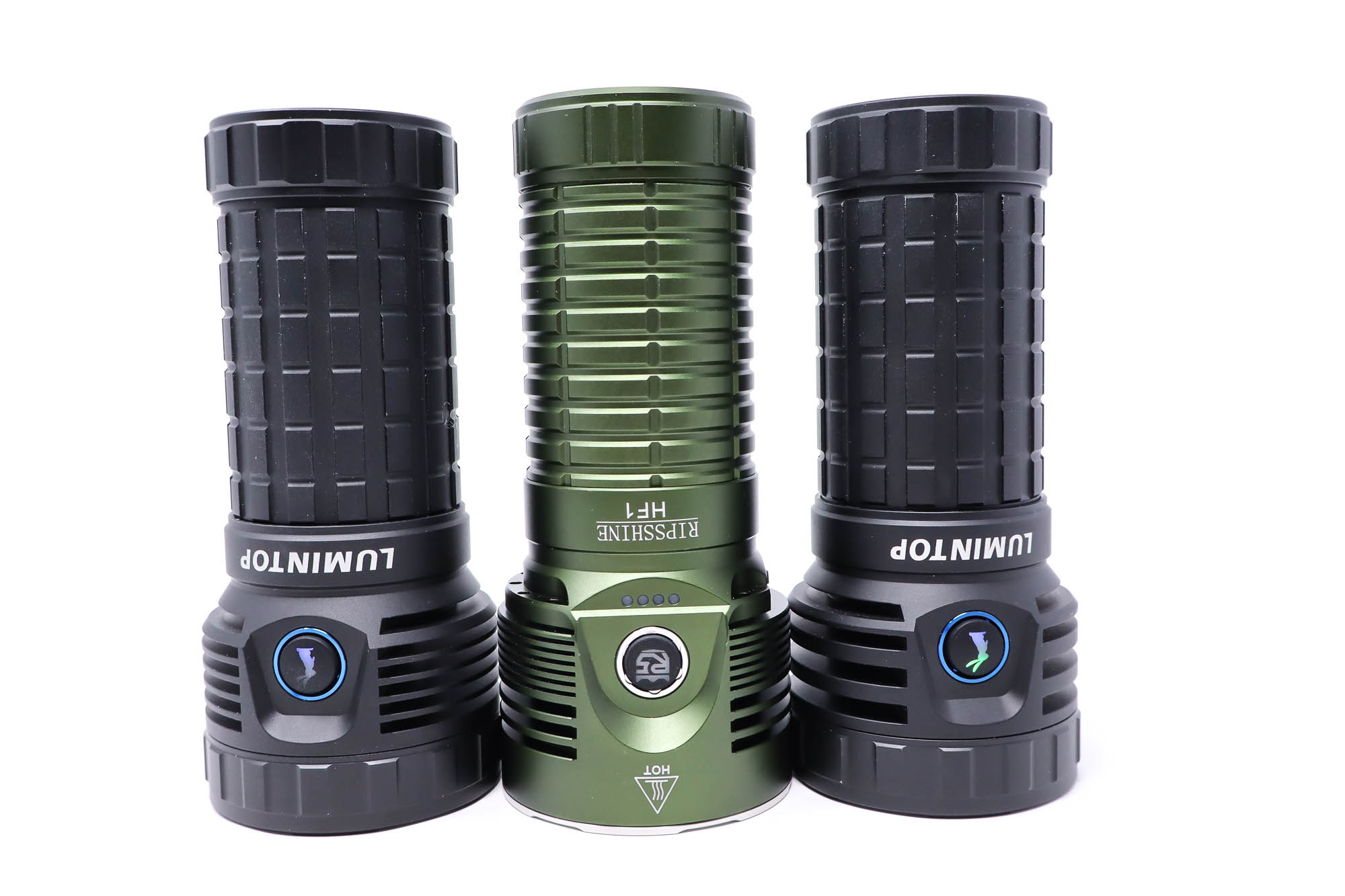
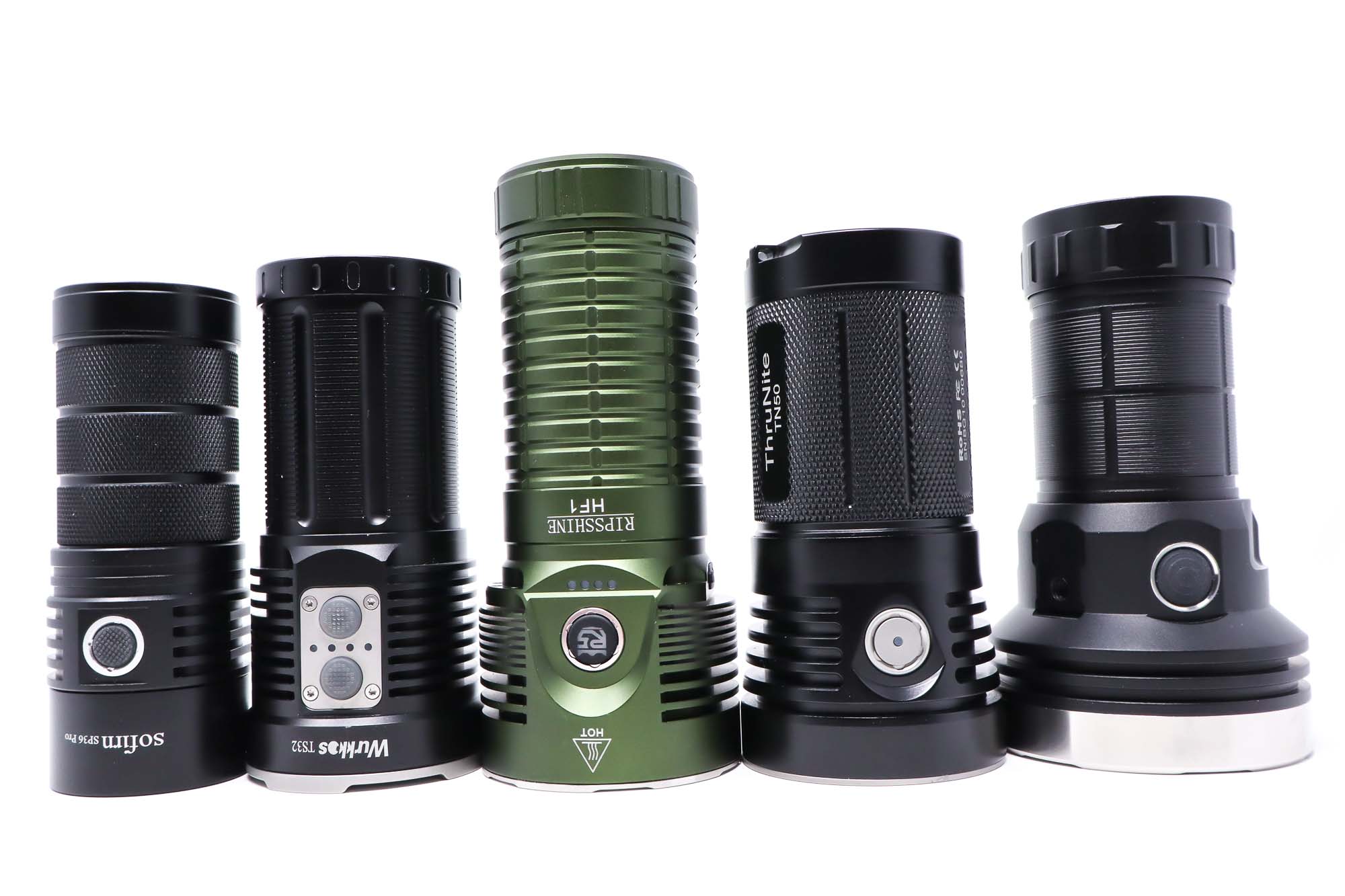
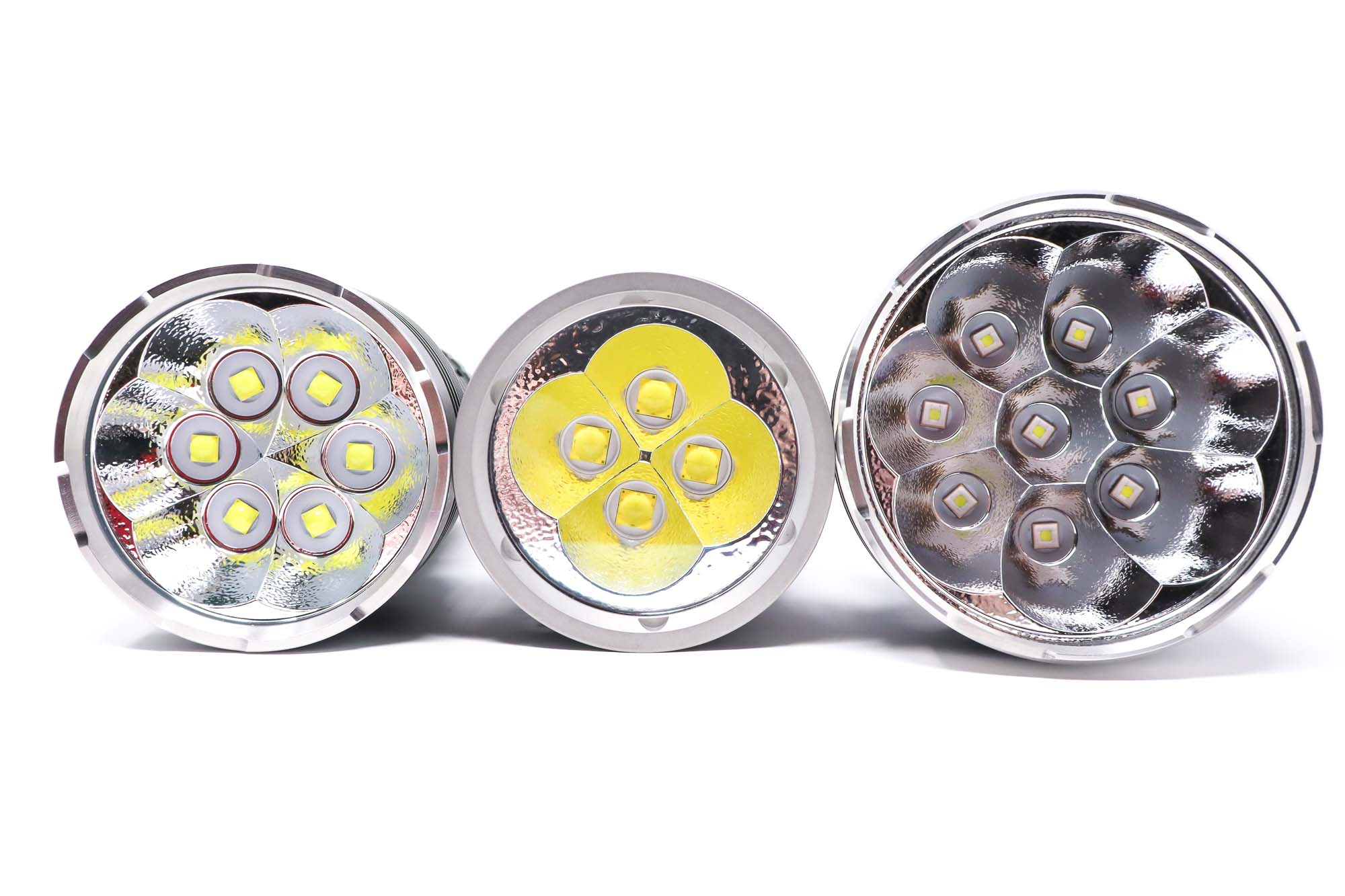
Ripsshine HF1 UI: User Interface and Driver
The details are sketchy with the driver, but the early announcements of this light on BLF from Ripsshine specified it had a fully regulated driver. That would mean this is the first affordable fan-cooled 20,000 Lumen light with a regulated driver, but the runtimes will confirm or refute it. The UI is surprisingly well fleshed out, with smooth and stepped ramping, fan control, thermostatic fan control, and auto lockout (don’t worry, it can be disabled). There’s 5 stepped modes plus Turbo, with blinkies. To switch between smooth ramping and stepped ramping, triple click from on.
Available modes:
- Smooth ramping: Low, High
- Stepped ramping: Moon, Low, Mid 1, Mid 2, High, Turbo
Available blinky modes:
- Strobe, S.O.S, Beacon
From OFF:
- Press and hold: Moon
- Single click: Turns on in last memorized mode (smooth and stepped ramping)
- Click and hold: Momentary Turbo
- Double click: Turbo
- 4 clicks: Electronic lockout
- 5 clicks: Enables/disables the fan (fan ON is indicated by a red LED under the switch)
From ON:
- Press and hold (smooth and stepped ramping): Ramps up
- 1 click: Turns off
- Double click: Turbo
- 3 fast clicks: Switch between smooth and stepped ramping
- Click, hold: Momentary Turbo
- Click, click, hold: Strobe
Mode memory:
- Yes, last mode memory, but Turbo and blinkies are not memorized
Shortcuts:
- To Moon: Press and hold from off
- To Turbo: Double click from on/off
- Instant Turbo: Click, hold from on/off
- Instant Strobe: Click, click hold from on/off
- To Strobe: In Moon, double click or in Turbo, triple click
Low voltage warning/protection:
- Yes. For 3.6 volts and under, the Turbo and High are not available. The light is limited to 60% output if the battery is 3.2 volts.
- Under 3.2 volts, the light will flash 3 times when turned on twice with a pause in between followed by a step down to 20% output.
- Below 3 volts, only Moon is available, and the output shuts off under 3 volts.
- There are 4 LEDs above the switch that show battery state.
- 1 LED on, 25%, 2 LEDs on 50%, 3 LEDs, 75%, 4 LEDs for >90%.
- During testing, the light output dropped very low when down to 1 blinking LED. The light powered off for LVP, but could be reactivated in Moon.
Strobe/blinkies
- Strobe, SOS, Beacon
Lock-out mode:
- Electronic lockout is activated by
- Automatic lockout: If the light sits idle for 10 minutes when off, the output is locked. The auto lock can be disabled/enabled. From off, click the switch 10 times to enable/disable the lockout. The light flashes two times when the lock is disabled.
PWM
- None visible with the naked eye
Additional/summary info on the UI:
- I’m glad Ripsshine didn’t flash this thing with Anduril because this is a nice, simple, easy to use UI. No configuring, no tweaking, just turn it on and go. Easy! It also has some nice features as well, with auto lock out which can be disabled (it’s disabled from the factory), smooth or stepped ramping, and some handy shortcuts.
- All good stuff. The fan is thermostatically controlled by the UI. At 55 C, the fan comes on, and turns off around 47 to 45 C (by my testing) and it works reliably. In Turbo, the fan is activated from turn-on. The switch backlight is always on in standby, can also be disabled with 7 clicks from off.
Ripsshine HF1 Charging and batteries
The Ripsshine HF1 employs the hugest battery you can get in a flashlight right now: The 46950 li-ion cell. The HF1 comes with a Ripsshine branded 32,000 mAh proprietary cell (they actually all are), with a raised positive terminal and ground contact (negative) integrated on the top of the battery. This cell can feasibly deliver 118 Wh (assuming 3.7 volts), and you’d need six, 5000 mAh 21700s to get the same kind of energy.
While not the best for energy density (these batteries are heavy…400 grams), they stand alone in the (hand portable) li-ion battery hierarchy. For charging, you get onboard USB type C at QC2 and 3 for up to 18 watts (5v 3a, 9v 2a, 12v 1.5a). There’s also a power bank feature present, for the same QC2/3 speeds.
On the Ruideng AT35 USB A tester and Hidance USB C tester I was seeing 9 volts 2 amps and 12 volts 1.5 amps on the charging and the same on the power bank side, so you’re limited to about 19 watts for both. While this isn’t slow, when charging up a 32 Ah battery, even at 18 watts, it still takes over 9 hours, and it did for me. My USB tester stops measuring capacity at 12 Ah, but it still counts the electrons, and I would get between 110 and 127 Wh after about 10 hours. The charging terminated between 4.18 and 4.19 volts.
| Charge type | Fits | No fit | Charge time |
|---|---|---|---|
| Onboard USB-C | Included 46950 cell | Everything else | Around 10-11 hours |
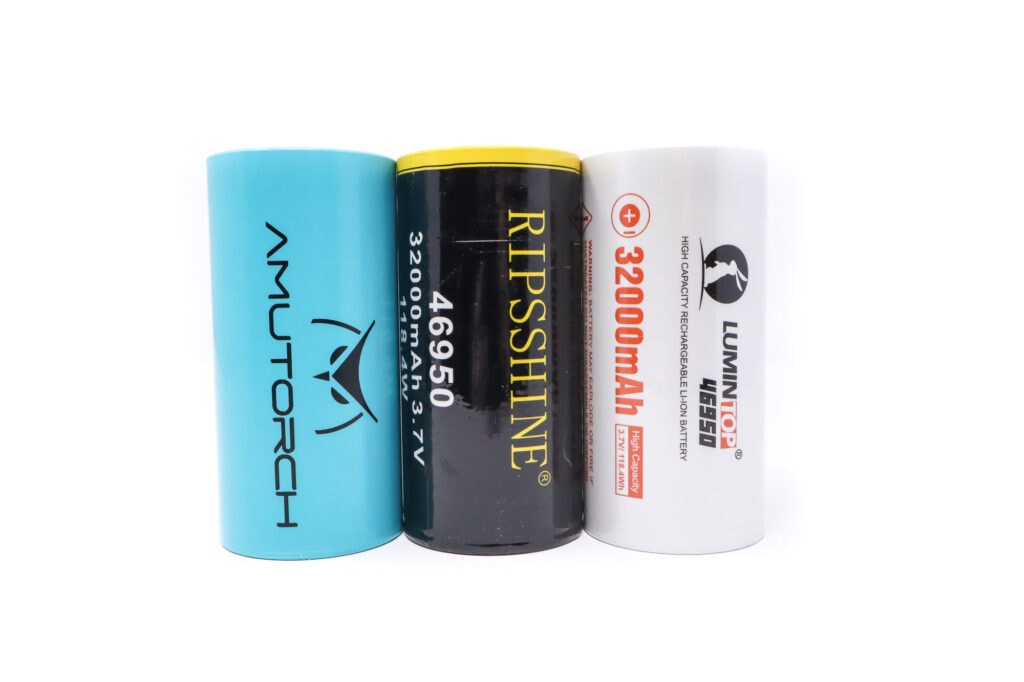
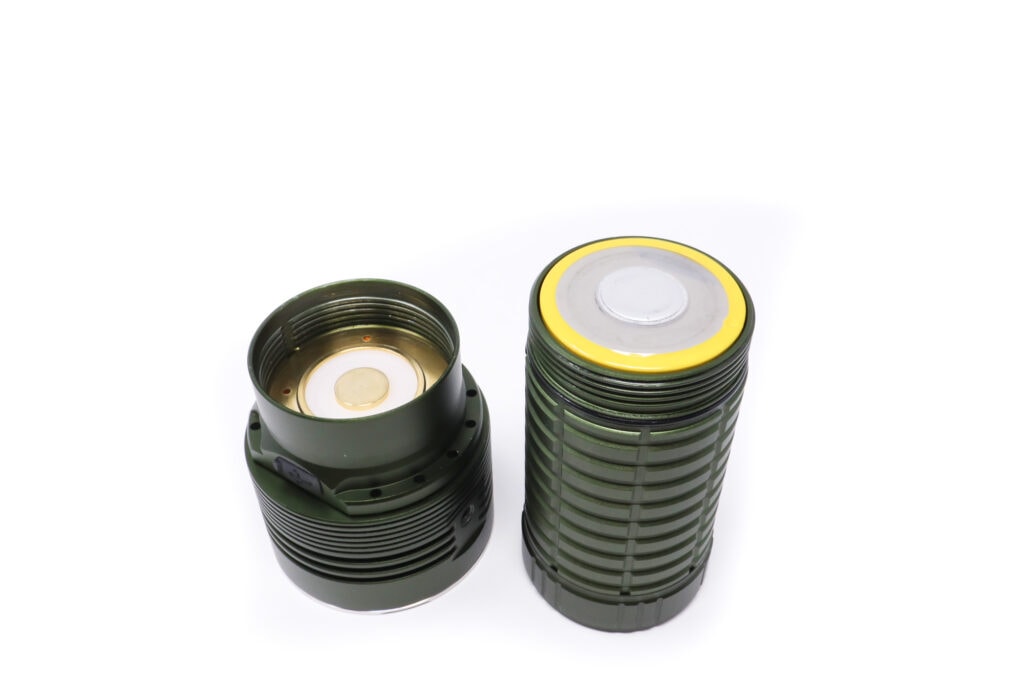
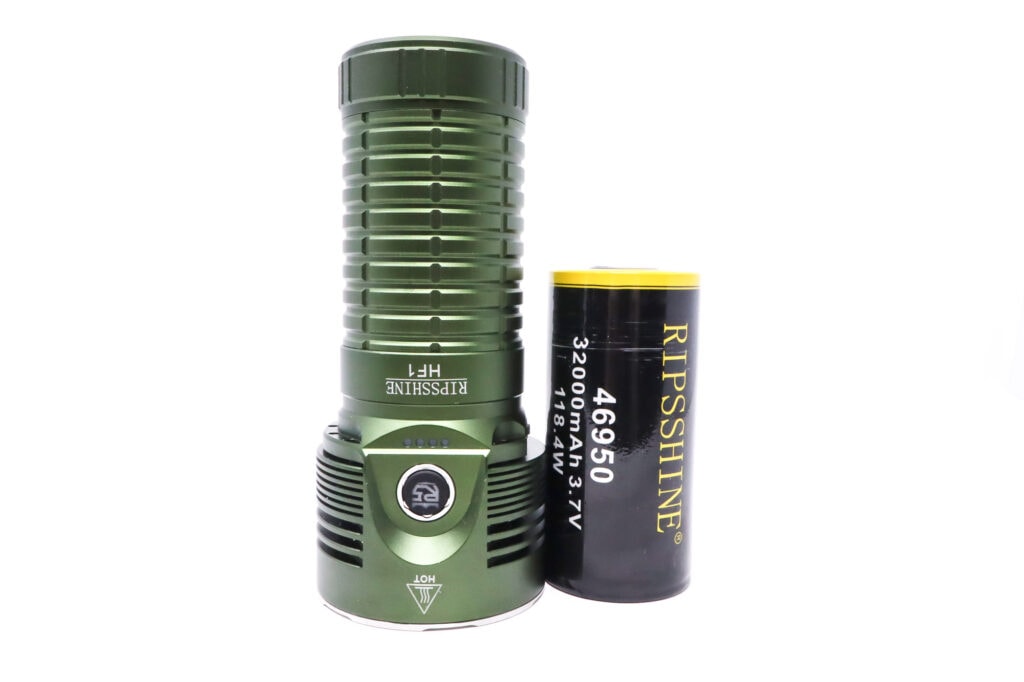
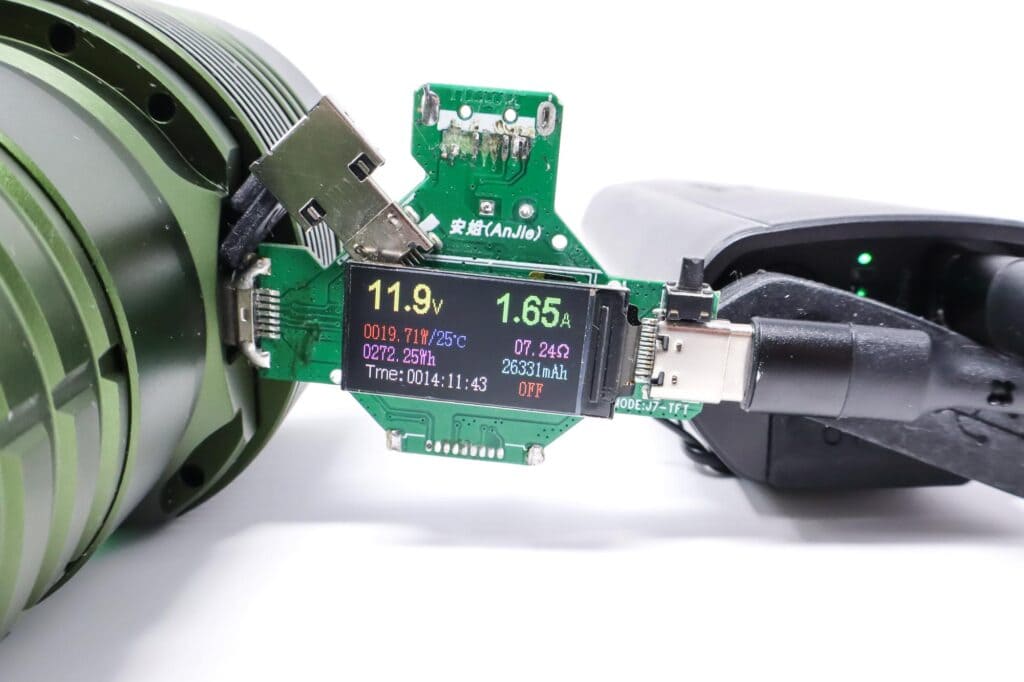
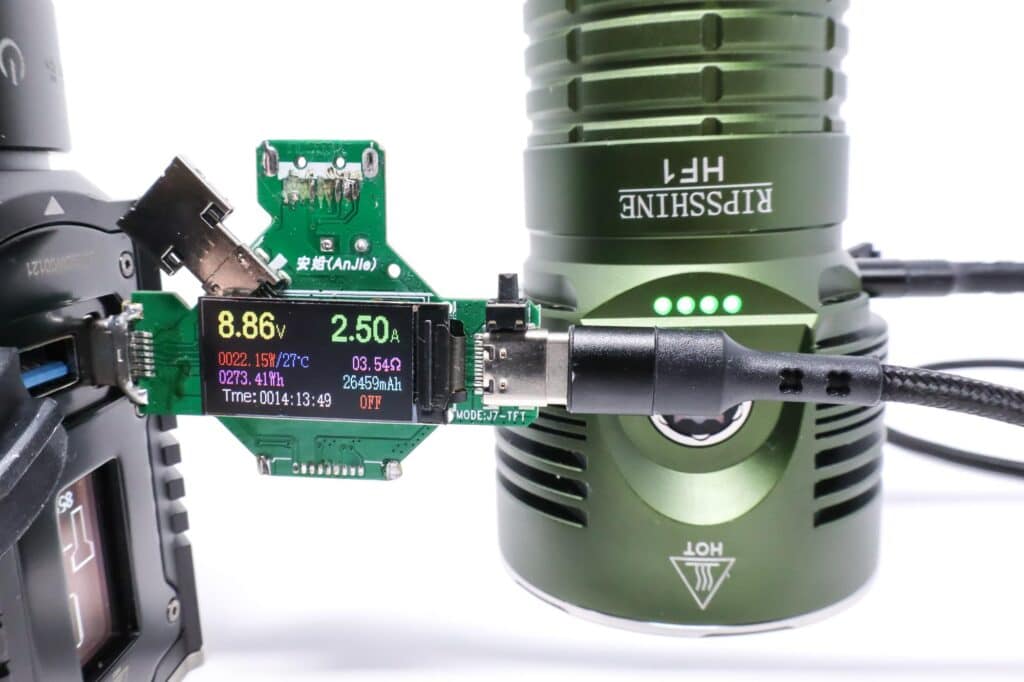
Performance test
Lumen measurements
How Lumens are Measured: Understanding ANSI FL1 Standards How Lumens are Measured: Understanding ANSI FL1 Standards: The ANSI FL1 standards specify that output in lumens should be measured 30 seconds after turning on, as this is the standardized time for measuring brightness according to the industry standard. This is why we focus on this part in our measurements. The ANSI FL1 standards require an ambient temperature of 22 ± 3°C. We record the ambient the ambient temperature to identify potential reasons for any observed discrepancies.Lumens are measured in my 50 cm integrating sphere with a Digi-Sense 20250-00 data logging luxmeter. The sphere has been calibrated with a Convoy S2+ measured to 260 Lumens and the figures are within 10% of actual. No current measurements due to the isolated current path. The battery was fully charged prior to the testing.
| Mode | Specified | Turn on | 30 sec. | 10 min. |
|---|---|---|---|---|
| Moon | 5 | 4.9 | 4.9 | – |
| Low | 800 | 738 | 738 | – |
| Mid 1 | 2000 | 1795 | 1795 | – |
| Mid 2 fan off | 5150 | 4551 | 4551 | 4428 |
| Mid 2 fan on | – | 4428 | 4428 | 4305 |
| High fan off | 10,900 | 9549 | 9348 | 3690 |
| High fan on | – | 9471 | 9348 | 8118 |
| Turbo fan off | 20,000 | 17,220 | 15,744 | 3567 |
| Turbo fan on | – | 17,220 | 16,113 | 7872 |
Ambient temperature during testing:
- 19 °C
Parasitic drain:
- N/A
Looking at the numbers, I’m pretty close to the advertised spec, which is always nice to see. The sustained outputs are also telling: The fan makes a BIG difference in output over time. ANSI doesn’t really tell us much, since it’s not until about the 120 second mark that the fan comes on for High mode, and a little longer for Mid 2 (closer to 4 minutes). Turbo output without the fan takes a big hit also, with less than 50% of the fan-on Turbo output at 10 minutes.
Ripsshine HF1 Battery Life: Runtime graphs
How Runtimes are Measured: Understanding ANSI FL1 Standards About ANSI FL1 runtime standards: The runtime is measured until the light drops to 10% of its initial output (30 seconds after turning on). This does not mean that the flashlight is not usable anymore. The last column shows how long the light actually works till it shuts off. If there is a + symbol, it means that the test was stopped at that particular point, but the light was actually still running. This happens on certain occasions, with certain drivers, firmware, or batteries.Lumens are measured in my 50 cm integrating sphere with a Digi-Sense 20250-00 data logging luxmeter. The sphere has been calibrated with a Convoy S2+ measured to 260 Lumens and the figures are within 10% of actual. I use a Digi-Sense 20250-92 data logging thermocouple for the temperature measurements. The probe is affixed to the head using kapton tape and uses the same 5 second sampling rate for logging. The battery was fully tested before the tests and I tested Mid 2, High, and Turbo with both the fan on and off.
| Mode | Specified | Runtime (ANSI FL1) | Time till shut off |
|---|---|---|---|
| Mid 2 fan OFF | 5h 35min (total) | 5h 32m | 6h 43m |
| Mid 2 fan ON | 3h 30min | 3h 30m | 4h 38m |
| High fan OFF | 5h 16min (total) | 5h 17m | 6h 35m |
| High fan ON | 3h 20m | 2h 58m | 4h 36m |
| Turbo fan OFF | 4h 3m | 5h 39m | 7h |
| Turbo fan ON | 3h 20m | 2h 57m | 4h 27m |
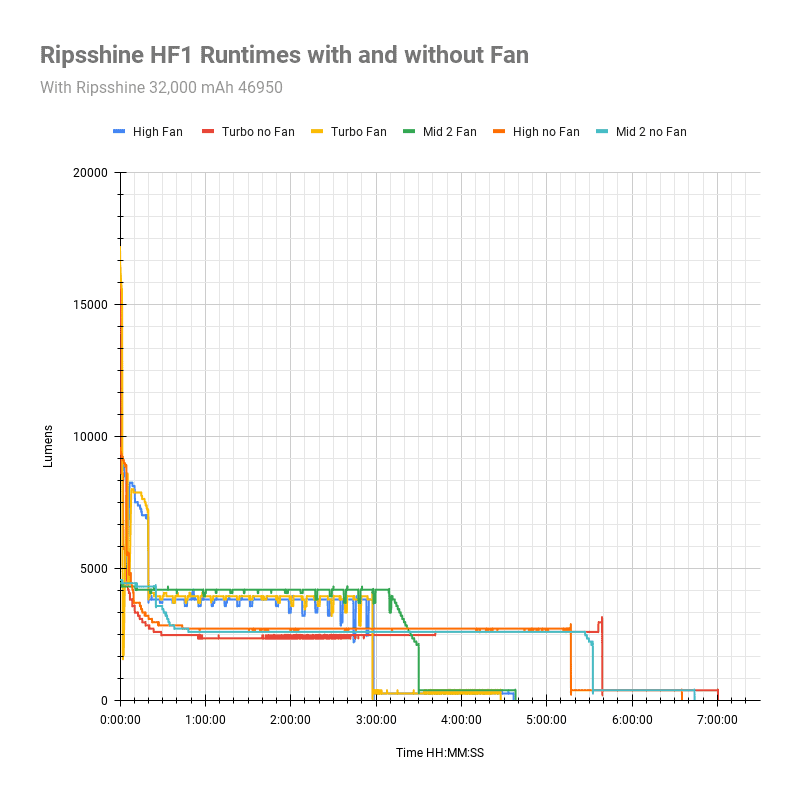
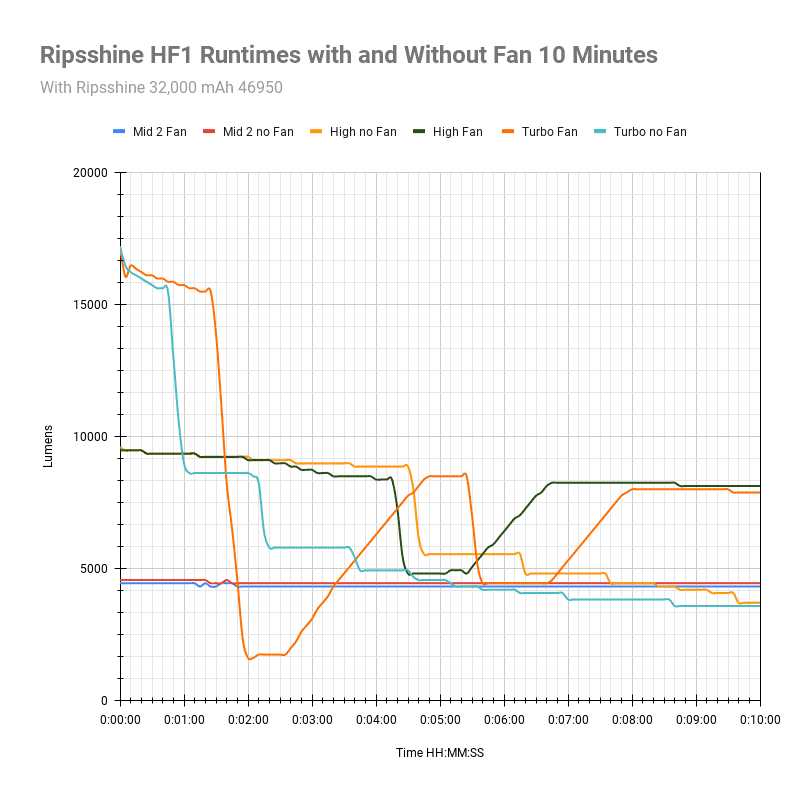
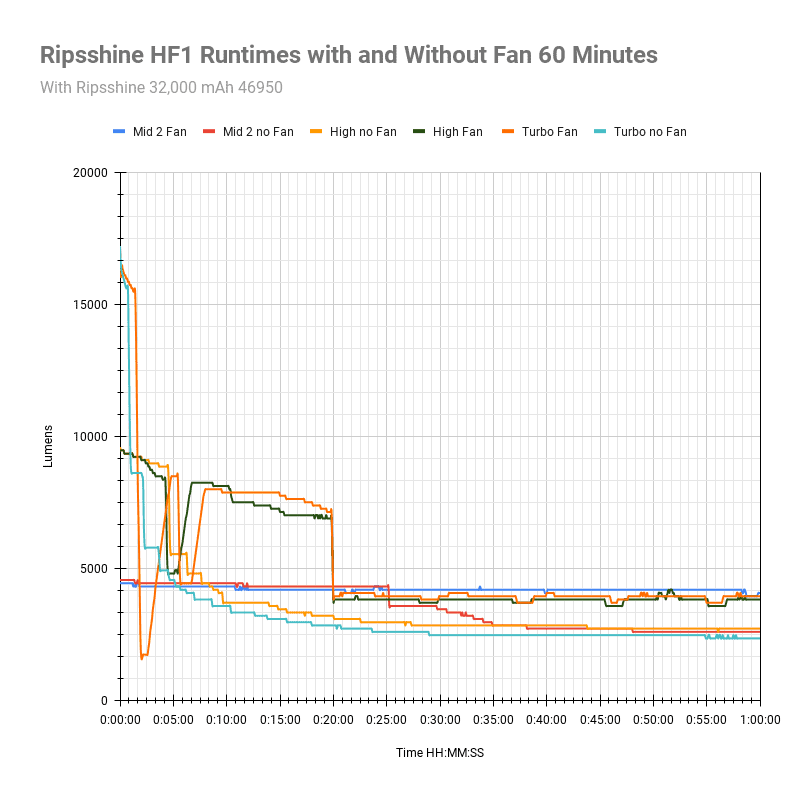
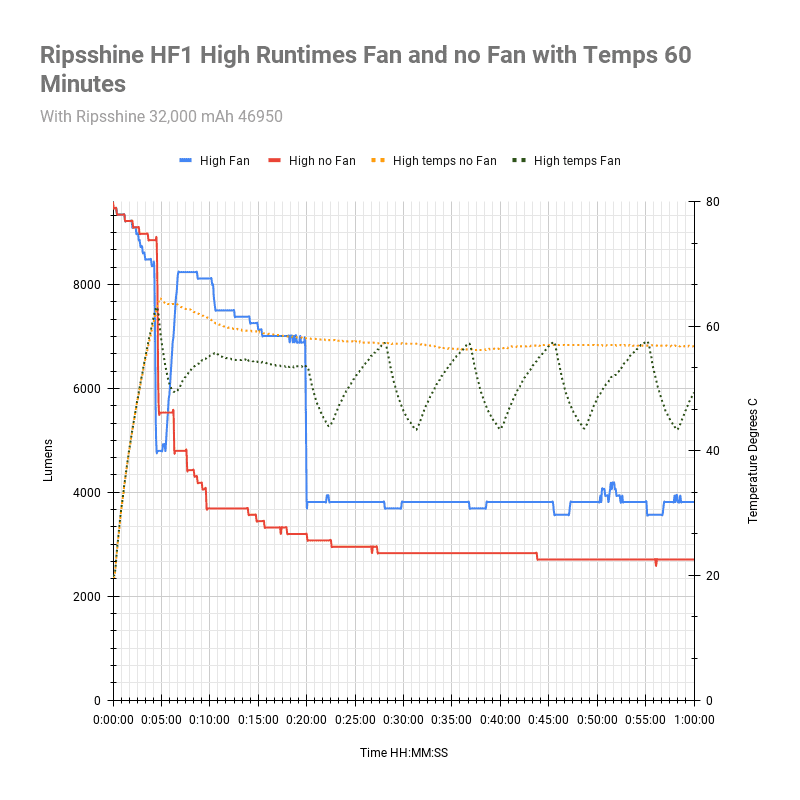
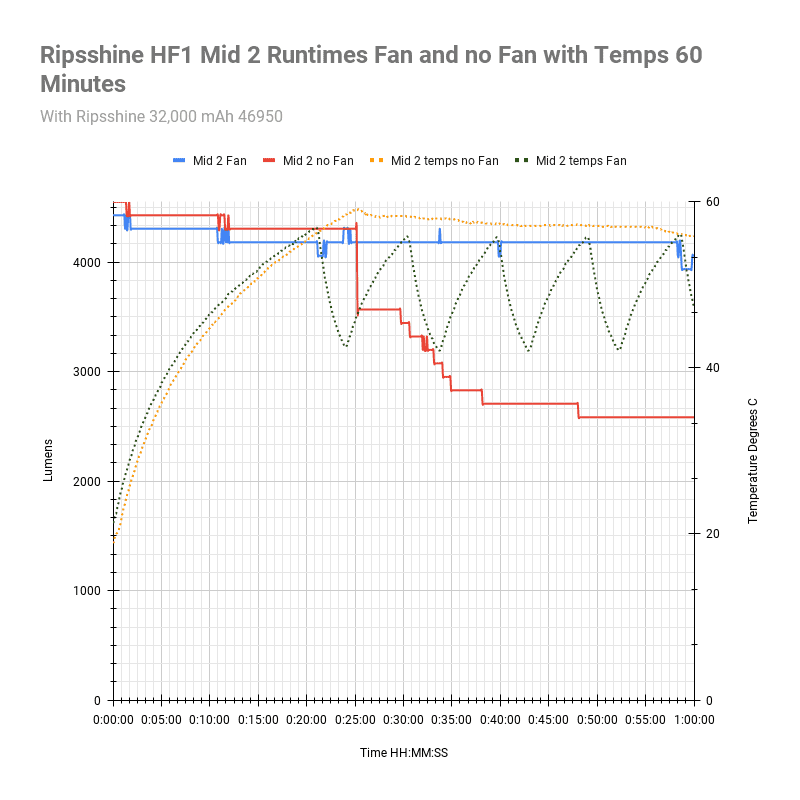
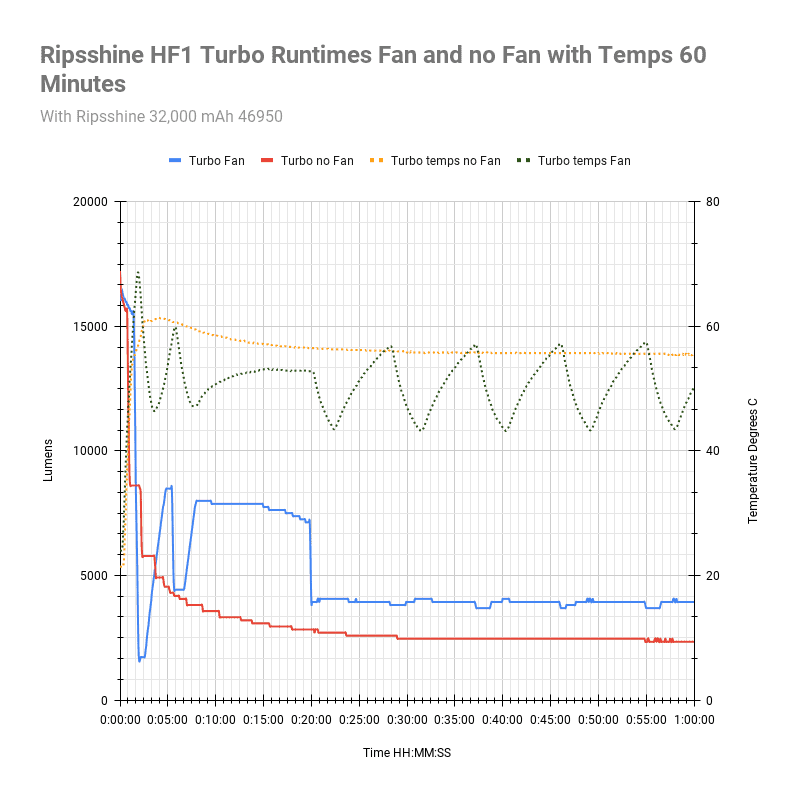
The advertised runtimes are super close to what I got. Looking at the graphs, we can see that the HF1 is indeed sporting a fully regulated driver and that’s awesome! The output for all modes (after the first step down for Turbo and High) is fully laminar, punctuated by minimal thermal blips when the fan kicks on and off. I had issues with my temperature logging for the Turbo fan-on and Mid 2 fan-on cutting out after an hour, so the temps weren’t captured for the entirety of those runtimes. There is thermal throttling coinciding with the fan on/off for High and Turbo.
The fan makes a big difference, not in total raw output, but runtime and sustained output. Obviously having an active cooling solution helps remove heat, and it shows. The fan comes on immediately for Turbo, but even so, there’s a deep step down in output before it thermally recovers. Like with the Lumintop Mach, the fan helps sustained output, but at the expense of reduced runtime overall as the higher output uses the battery faster, and the fan running probably doesn’t help much either.
I compared some other high output lights to the HF1, including the two Lumintop competitors in the Mach V1 and Mach 4695. Looking over the comparison between the Machs and the HF1, you can see how the fully regulated driver makes a difference. The HF1 has two fewer LEDs than the Machs. Overall, impressive performance from the HF1. The battery was discharged to 3 volts after the tests.
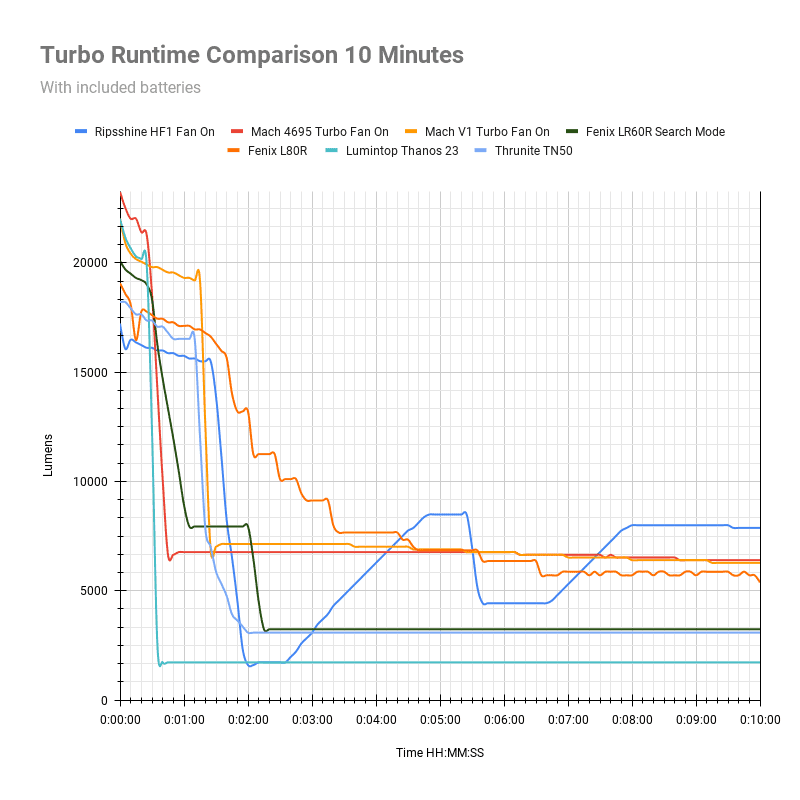
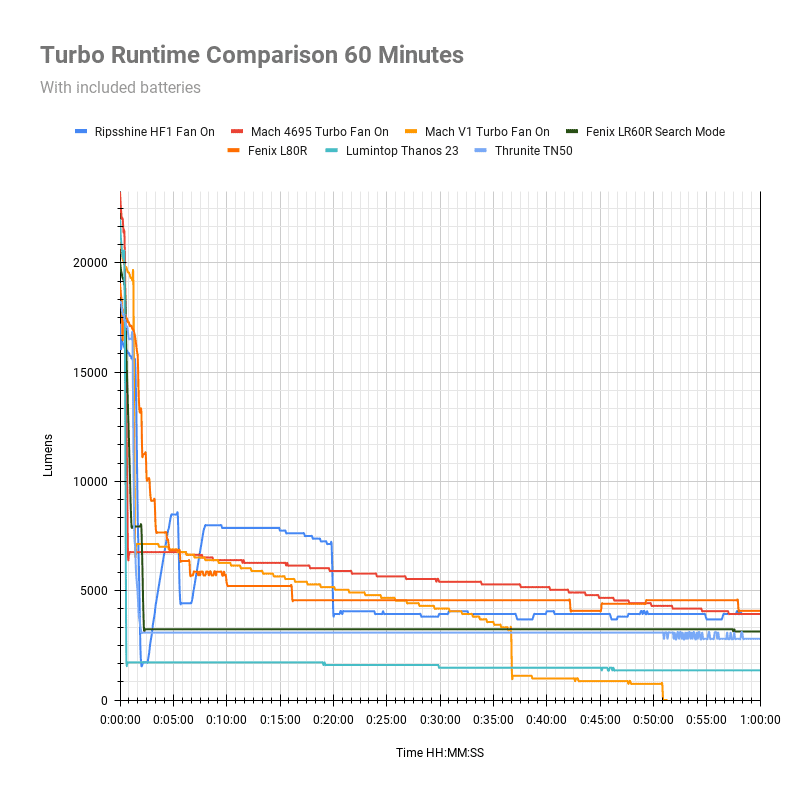
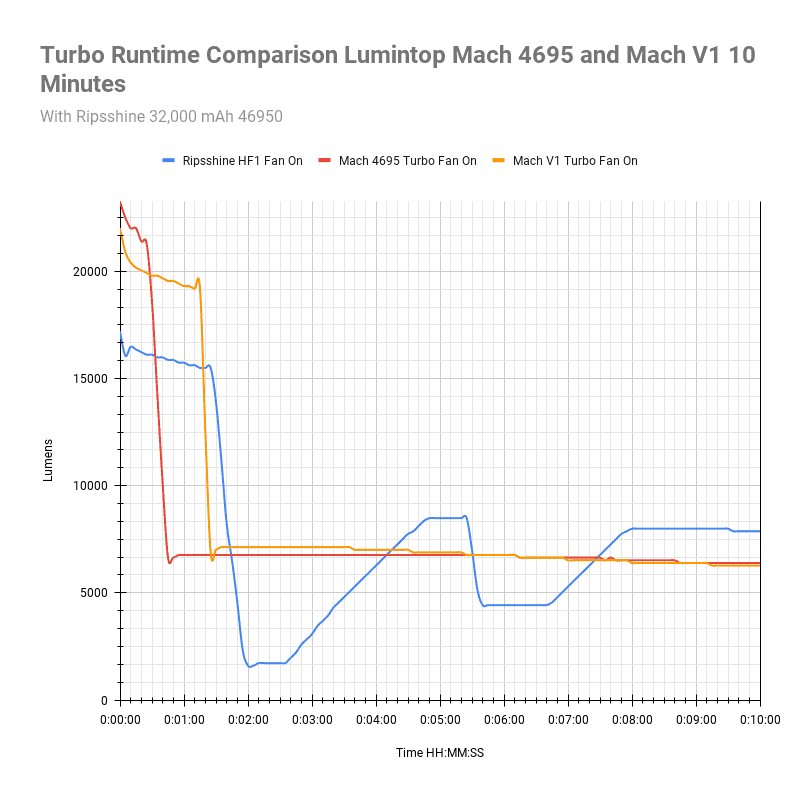
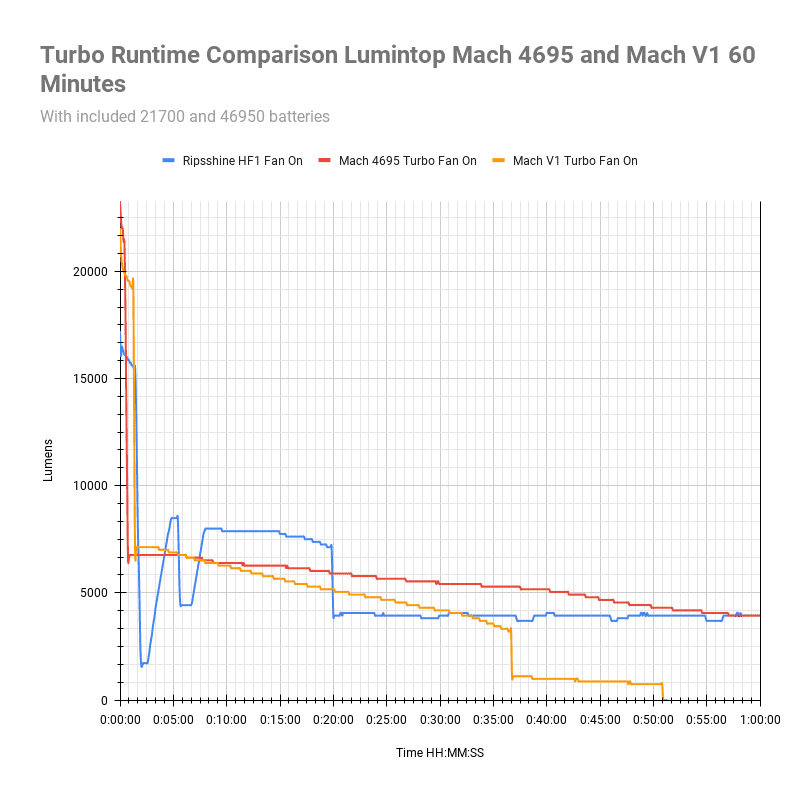
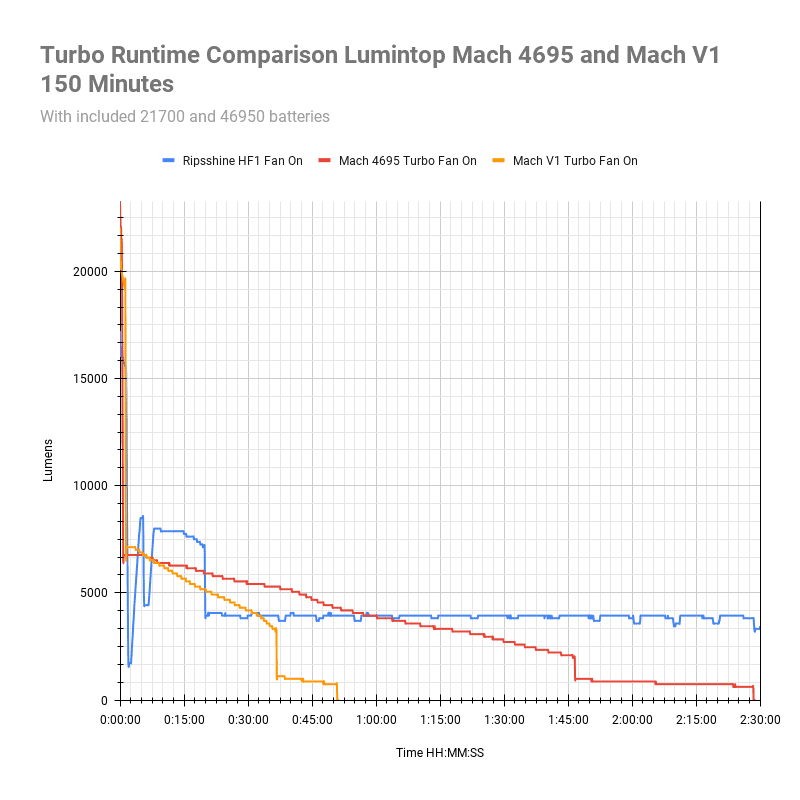
Peak beam intensity and beam distance measurements
About Peak beam intensity: Understanding ANSI FL1 Standards About peak beam intensity The calculated value of distance in meters at which the flashlight produces a light intensity of 0.25 lux. (0.25 lux is about the brightness of a full moon shining on an object). This means that the intensity has decreased so much, it becomes difficult to see darker objects, or objects that don’t reflect light. The columns ‘Meters’ and ‘Yards’ use rounded numbers.Beam distances are measured using a Uni-T UT383S luxmeter measured indoors at 5 meters using the included fully charged battery. Measurements taken at 30 seconds.
| Mode | Specified | Candela measured | Meters | Yards |
|---|---|---|---|---|
| Moon | ? | 800 | 57 | 62 |
| Low | ? | 2800 | 106 | 116 |
| Mid 1 | ? | 6450 | 161 | 176 |
| Mid 2 | ? | 16,300 | 255 | 279 |
| High | ? | 34,450 | 371 | 406 |
| Turbo fan on | 70,225 | 57,700 | 480 | 525 |
| Turbo fan off | ? | 37,775 | 389 | 425 |
| Turbo at start | ? | 61,725 | 497 | 544 |
Ambient temperature:
- 18.9 °C
Ripsshine only listed a single candela/beam distance figure (I assume it’s Turbo), and at turn-on, I’m coming up a bit short on that one. The beam distance for this light is good! Not far off from the Lumintop Mach V2 (which has 2 extra LEDs).
Beamshots
Camera settings and distance: Photos taken with a Canon EOS R100 and Canon RF-S 18-45mm STM lens set to 0.3s, f5 ISO 1600 and 5000K WB. The fence is 95 meters away. The trees beyond the fence are about 150 meters distant.
Beamshots of the following flashlights compared:
- Ripsshine HF1
- Lumintop Mach 4695 V2
- Lumintop Mach V1
- Lumintop Thanos 23 (flood+spot)
- Amutorch DM80
- Fenix LR60R (flood+spot)
- Thrunite TN50
- Fenix LR80R
Please note that the following beamshots are mainly intended to showcase the beam pattern and beam quality, rather than overall performance. These images are typically taken directly after activation, and in different seasons or weather conditions, and therefore do not fully represent its overall performance. For accurate performance metrics, such as output, beam distance, and runtimes, you need to look at the performance section of this review.


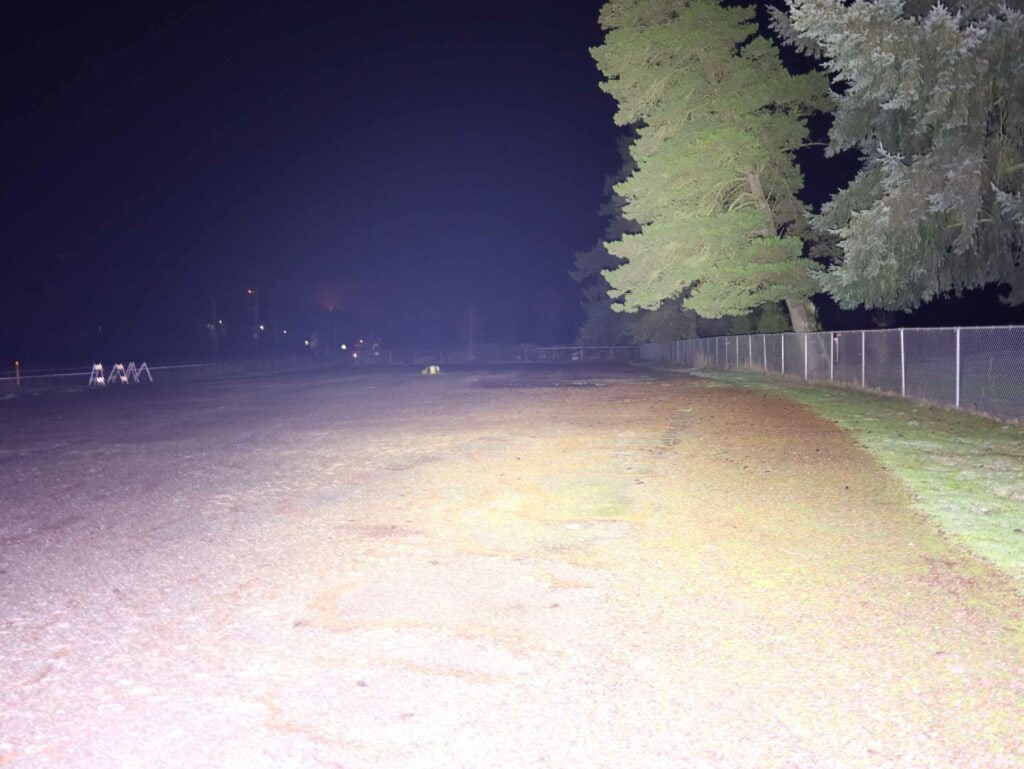
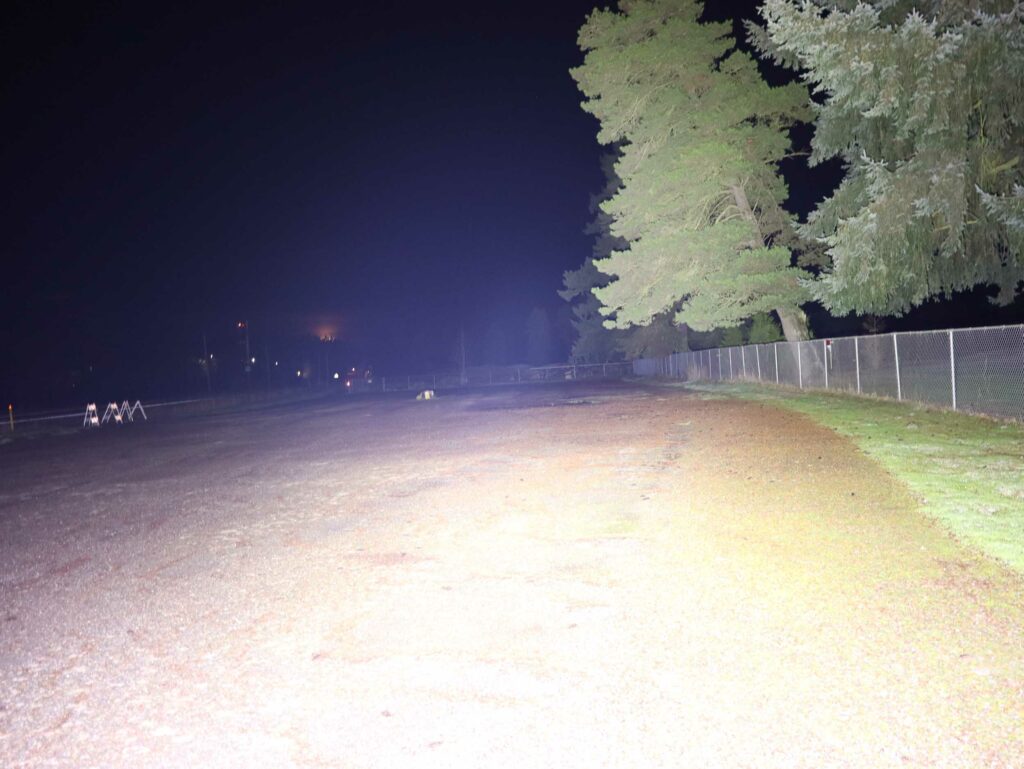
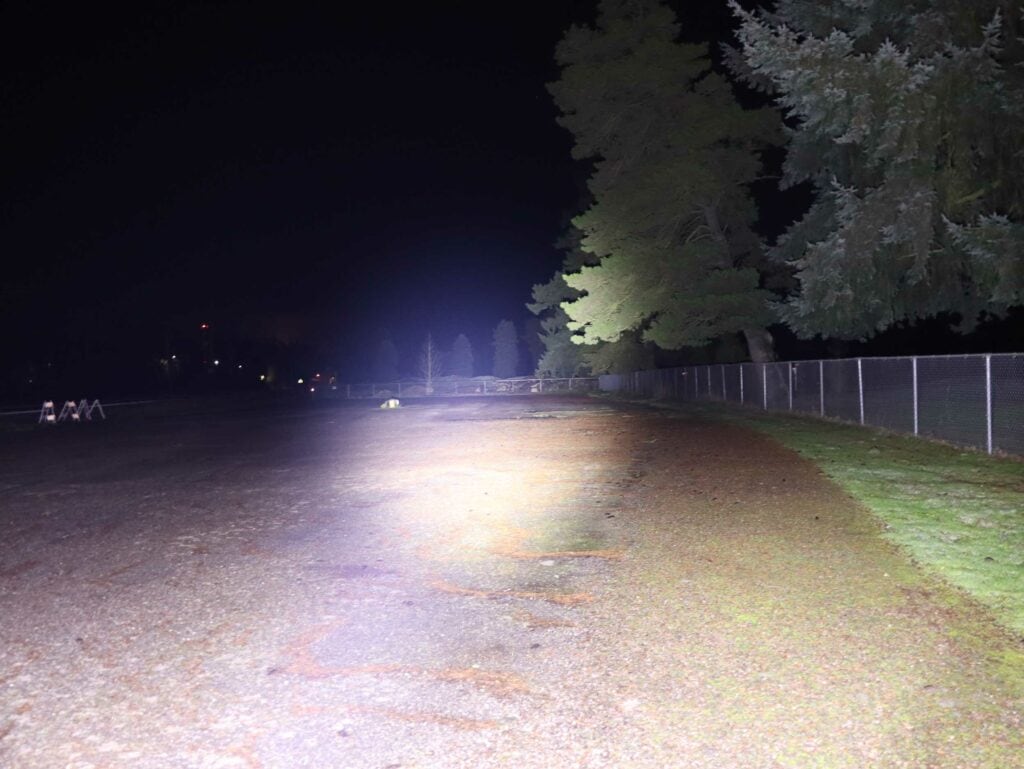
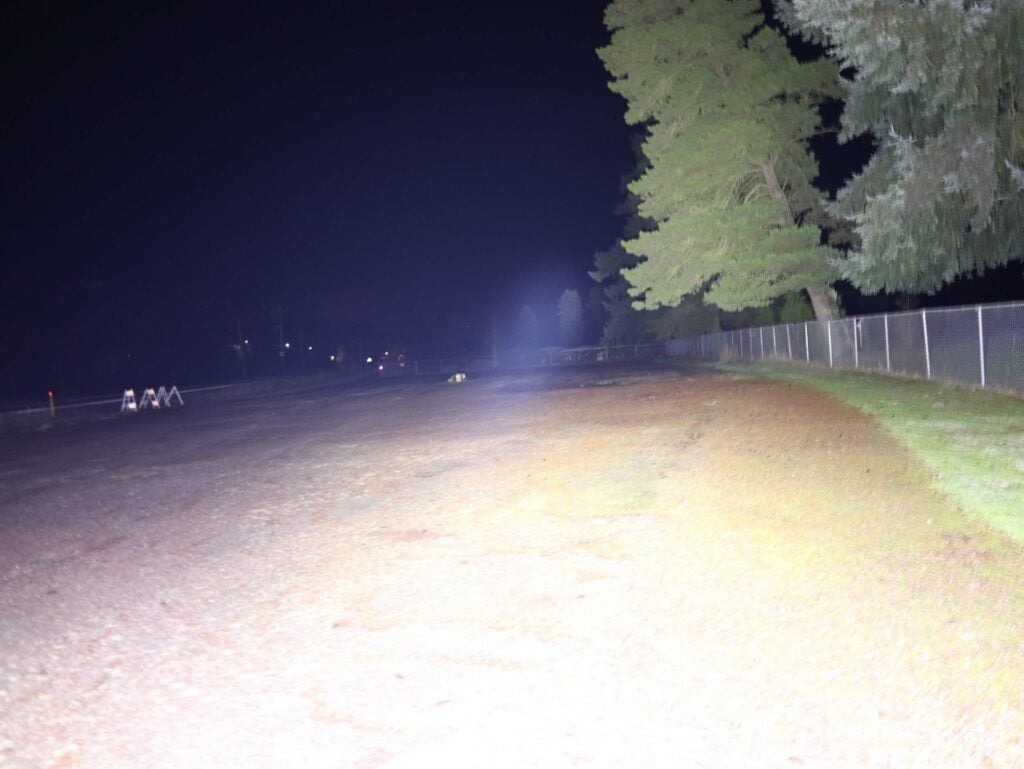
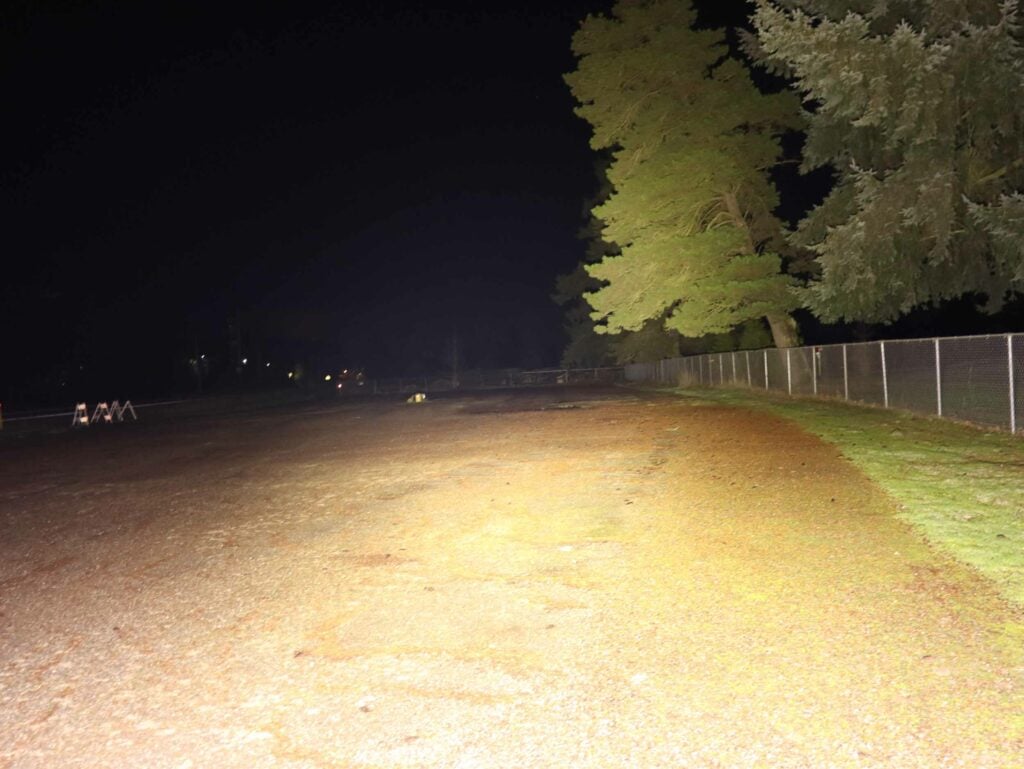
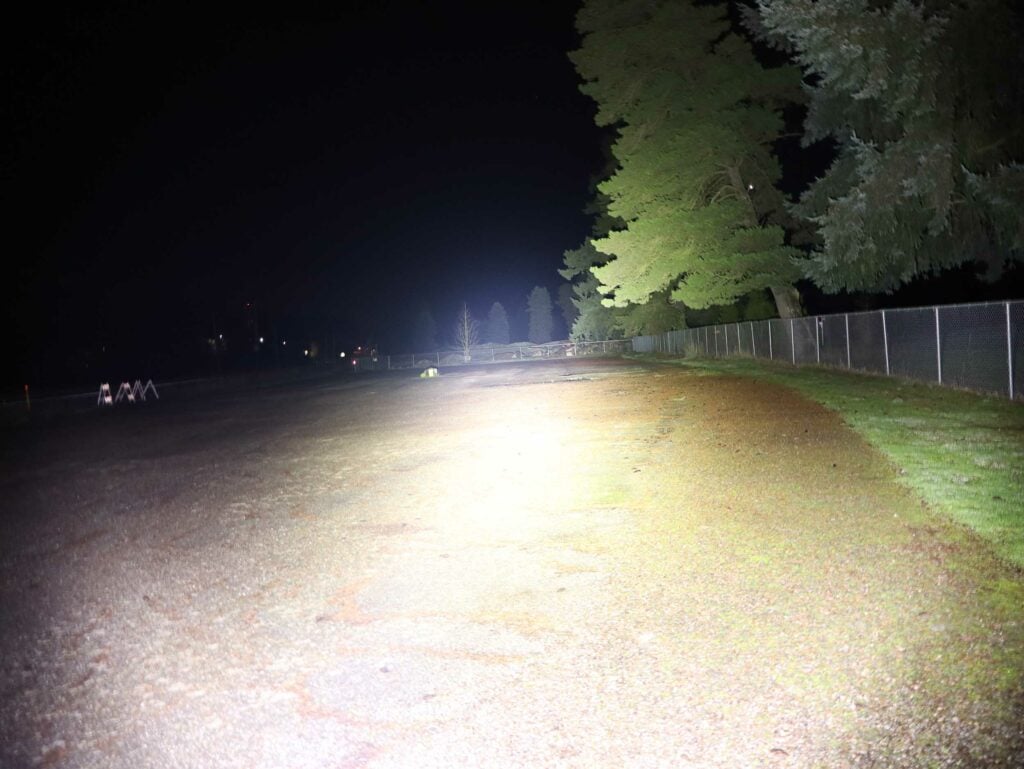
Disclaimer: This flashlight was sent to us for review at no cost by Ripsshine. We have not been paid to review, nor have we been holding back on problems or defects.
Final Verdict
Pros
- Affordable
- Fully regulated driver
- Long runtimes
- Great sustained output
- Onboard USB C charging
- Power bank
Cons
- Charging could be faster
- Battery could be hard to source for a replacement
- Deep step down on Turbo mode with the fan
Explanation on star ratings:
1: Avoid: a match would be a better choice – 2: Poor: significant defect or issues; almost unusable – 3: Average: some defects or issues; but still usable 4: Good: recommended (minor issues) – 5: Great: highly recommended

4.5 stars: ★★★★⋆
While our star rating provides a reliable indicator, we encourage you to read the full review to make an informed decision based on your own needs and preferences.
Before the Lumintop Mach made it possible to join the ‘fan club’ and get a fan-cooled high output flashlight, your choices were limited to lights starting at $350, which were very large and very heavy. Thanks to advances in technology, now smaller lights are available with fan cooling, and I’m glad to see this expanding.
The HF1 from Ripsshine is an example of a start-up company capitalizing on those advances enjoyed almost exclusively by Lumintop’s Mach lights. This HF1 is a bit different, but follows the same pattern with some similarities and improvements. The fully regulated driver is a very welcome addition and really contributes to laminar sustained output with the fan running.
I like the revised reflector design since it gives a bit more useful beam, and the UI is also improved, with more versatility thanks to smooth and stepped ramping. It’s still heavy and bulky, but not nearly as big or bulky as other fan-cooled lights from Acebeam or Imalent.
It’s not perfect though, and the same pain points I have with the Machs are here, like unimpressive charging rates and proprietary battery with questionable reliability and replacement options. There’s also a deep step down in Turbo with the fan on, but otherwise, this is a pretty well-rounded and thought out flashlight that bridges the gap between the more expensive fan-cooled offerings, and I think represents a glimpse into the not-too-distant future of handheld, portable lighting.
This is one that I recommend if you want a fan-cooled light, and a compelling alternative to the Mach(s). 4.5 stars for the Ripsshine HF1.
Buy your Ripsshine HF1 here
1lumen selects and reviews products personally. We may earn affiliate commissions through our links, which help support our testing.